Paul van Yperen's Blog, page 202
March 26, 2020
Henry Wilcoxon
British actor Henry Wilcoxon (1905-1984) was best known as a leading man in Cleopatra (1934) and many others of Cecil B. DeMille's films. He also served as DeMille's associate producer on his later films.
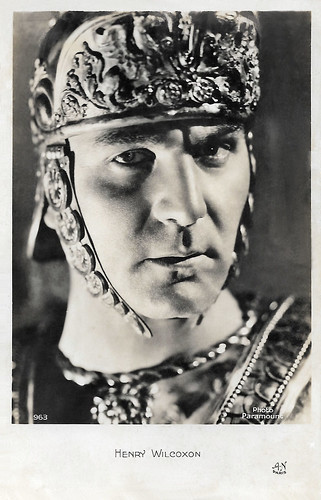
French postcard by A.N., Paris, no. 963. Photo: Paramount. Henry Wilcoxon in Cleopatra (Cecil B. DeMille, 1934).
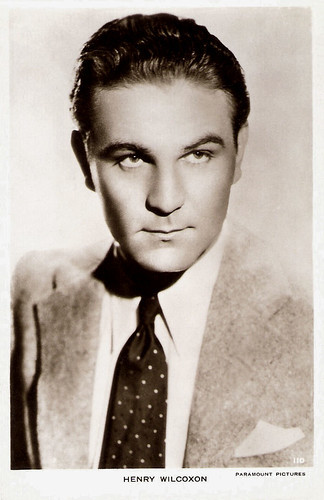
British Real Photograph postcard, no. 110. Photo: Paramount Pictures.
Ill from malnutrition and neglect
Harry Frederick Wilcoxon was born on 8 September 1905 in Roseau, Dominica, British West Indies. His father was English-born Robert Stanley 'Tan' Wilcoxon, manager of the Colonial Bank in Jamaica and his mother, Lurline Mignonette Nunes, was a Jamaican amateur theatre actress, descendant of a wealthy Spanish merchant family. His older brother was Robert 'Owen' Wilcoxon.
Henry had a difficult childhood. His mother disappeared suddenly and mysteriously when he was about a year old, and his father took him and Owen to England with the intention that his own mother Ann would take care of them. But, because his mother was too frail to care for the children, they were first sent to a foster home, where they became ill from malnutrition and neglect and they were moved on to an orphanage. There, Harry suffered from rickets, and Owen developed a stutter and had epileptic fits. They were rescued from the orphanage to a new foster home.
After several years Harry's father 'Tan', with his new wife Rosamond took the children home with them to Bridgetown, Barbados, where they were educated. Harry and Owen became known as 'Biff' and 'Bang' due to their fighting skills gained in amateur boxing. After completing his education, Wilcoxon was employed by Joseph Rank, the father of J. Arthur Rank, before working for Bond Street tailors Pope and Bradshaw. While working for the tailors, Wilcoxon applied for a visa to work as a chauffeur in the United States, but upon seeing his application refused, turned to boxing and then to acting.
His first stage performance was a supporting role in an adaptation of the novel 'The 100th Chance', by Ethel M. Dell, in 1927 at Blackpool. Wilcoxon joined the Birmingham Repertory Theatre the next year and toured for several years.
He found critical success playing Captain Cook in a production of Rudolph Besier's 'The Barretts of Wimpole Street' at the London Queen's Theatre alongside Cedric Hardwicke . In 1932, He played at the Queen's Theatre in Sir Barry Jackson's production of Beverley Nichols' novel 'Evensong' alongside Edith Evans.
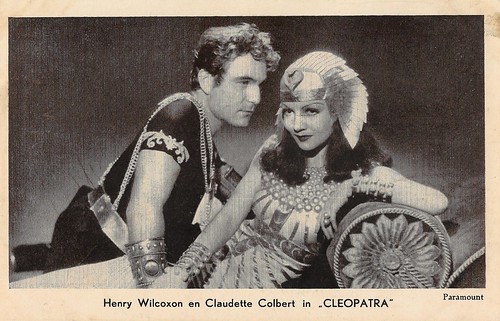
Dutch postcard. Photo: Paramount. Claudette Colbert as Cleopatra and Henry Wilcoxon as Marc Anthony in Cleopatra (Cecil B. DeMille, 1934).
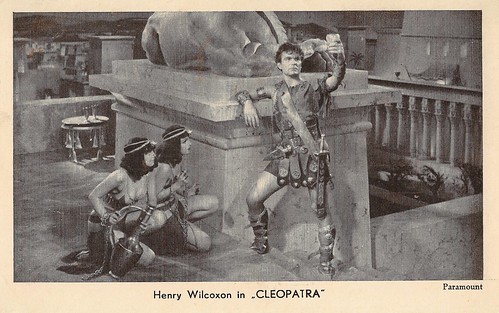
Dutch postcard. Photo: Paramount. Henry Wilcoxon as Marc Anthony in Cleopatra (Cecil B. DeMille, 1934).
The man-hungry Queen of Egypt
In 1931, Harry Wilcoxon made his screen debut as Larry Tindale in The Perfect Lady (Frederick J. Jackson, Milton Rosmer, 1931), followed by a role opposite Heather Angel in Self Made Lady (George King, 1932), alongside Louis Hayward. In 1932, he appeared in The Flying Squad (F.W. Kraemer, 1932), a sound remake of a 1929 silent film based on the novel by Edgar Wallace. Altogether he made eight films in Britain till 1934.
In 1933, a talent scout for Paramount Pictures arranged a screen test which came to the attention of producer-director Cecil B. DeMille in Hollywood. He cast Wilcoxon as Marc Anthony in Cleopatra (Cecil B. DeMille, 1934) opposite Claudette Colbert as the man-hungry Queen of Egypt. Harry was renamed by DeMille for the role and from then on he was Henry Wilcoxon.
He was next given the lead role of Richard the Lionhearted in DeMille's big-budget spectacle The Crusades (Cecil B. DeMille, 1935) opposite Loretta Young. That film, however, was a financial failure, losing more than $700,000. After the lack of success of The Crusades, Wilcoxon's career stalled. He starred in a number of B-films, like The President's Mystery (Phil Rosen, 1936) and Prison Nurse (James Cruze, 1938) for Republic Pictures, and he portrayed the supporting role of Maj. Duncan Heyward in the commercially successful Last of the Mohicans (George B. Seitz, 1936) starring Randolph Scott.
Wilcoxon himself called 'his worst acting job' Mysterious Mr. Moto (Norman Foster, 1938) featuring Peter Lorre . That year, he also played in If I Were King (Frank Lloyd, 1938) with Ronald Colman , and featured in Five of a Kind (Herbert I. Leeds, 1938) with the Dionne quintuplets. In Great Britain, Wilcoxon appeared as Captain Hardy in Lady Hamilton (Alexander Korda, 1941), alongside Laurence Olivier and Vivien Leigh .
When America entered the World War II in December 1941, Wilcoxon enlisted in the United States Coast Guard. He served with the Coast Guard until 1946, gaining the rank of Lieutenant. During his period of service, he had three films released in 1942, among them Mrs. Miniver (William Wyler, 1942), which received considerable public acclaim, as well as six Academy Awards. Wilcoxon, in his role as the vicar, re-wrote the key sermon with director William Wyler. The speech made such an impact that it was used in essence by President Roosevelt as a morale builder.
Upon his return from war service, Wilcoxon picked up with Cecil B. DeMille with Unconquered (Cecil B. DeMille, 1947), starring Gary Cooper . After starring as Sir Lancelot in the musical version of Mark Twain's A Connecticut Yankee in King Arthur's Court (Tay Garnett, 1949) with Bing Crosby in the title role, he featured in DeMille's Samson and Delilah (Cecil B. DeMille, 1949).
Wilcoxon returned to England to feature in The Miniver Story (H.C. Potter, 1950), a sequel to the multi-Oscar-winning Mrs. Miniver (1942) in which he reprised his role as the vicar opposite Greer Garson . In the late 1940s, young actors and actresses came to Wilcoxon and wife Joan Woodbury and asked them to form a play-reading group which in 1951 became the Wilcoxon Players.
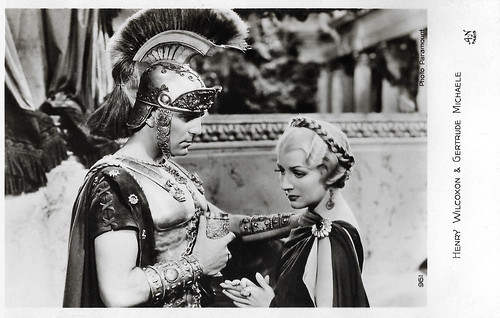
French postcard by A.N., Paris, no. 961. Photo: Paramount. Henry Wilcoxon as Marc Anthony and Gertrude Michael as Caesar's wife Calpurnia in Cleopatra (Cecil B. DeMille, 1934).
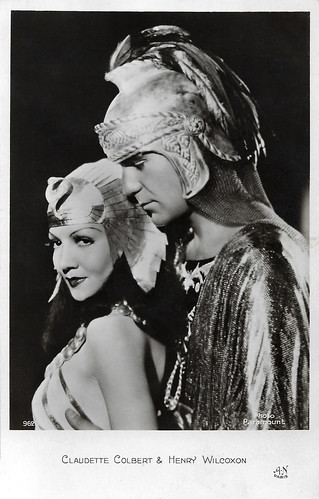
French postcard by A.N., Paris, no. 962. Photo: Paramount. Claudette Colbert and Henry Wilcoxon in Cleopatra (Cecil B. DeMille, 1934).
The World's Greatest Showman
Henry Wilcoxon played a small but important part as FBI Agent Gregory in DeMille's The Greatest Show on Earth (Cecil B. DeMille, 1952), on which he also served as Associate Producer. The film won the Academy Award for Best Picture in 1952. He also acted as associate producer on, and acted as Pentaur, the pharaoh's captain of the guards, in DeMille's remake of his own The Ten Commandments (Cecil B. DeMille, 1956).
Wilcoxon was sole producer on The Buccaneer (Anthony Quinn, 1958), a remake of DeMille's 1938 effort, which DeMille only supervised due to his declining health while his then son-in-law Anthony Quinn directed. After DeMille died, Wilcoxon worked on a film based on the life of Lord Baden-Powell, founder of the Boy Scout movement, which DeMille had left unrealised, and was also ultimately abandoned.
After a relatively inactive period, Wilcoxon appeared with Charlton Heston in The War Lord (Franklin Schaffner, 1965). He was co-producer on the TV tribute The World's Greatest Showman: The Legend of Cecil B. DeMille (1963). At the opening of the DeMille Theatre in New York, he produced another short film.
In the last two decades of his life, he worked sporadically and accepted minor acting roles in TV shows including The Big Valley (1965), I Spy (1966), It Takes a Thief (1968), Gunsmoke (1970), Lassie (1973), Cagney & Lacey (1982), and Private Benjamin (1982). He also appeared in a few films films like F.I.S.T (Norman Jewison, 1978), starring Sylvester Stallone.
He had a memorable turn as the golf-obsessed Bishop Pickering, struck by lightning, in the slapstick comedy Caddyshack (Harold Ramis, 1980) with Bill Murray as his caddy. His final film was Sweet Sixteen - Blutiges Inferno (Jim Sotos, 1983).
By loaning money from his early film acting, Wilcoxon assisted his brother Owen to establish himself in 1931 as a partner in the Vale Motor Company in London, and for a short time he showed a personal interest in the development of their sports car, the Vale Special.
At that time his girlfriend was a London-based American stage actress Carol Goodner. Wilcoxon married 19-year-old actress Sheila Garrett in 1936, but they divorced a year later. In 1938 he married his second wife, 23-years-old actress Joan Woodbury. They had three daughters: Wendy Joan Robert Wilcoxon (born 1939), Heather Ann Wilcoxon (1947) and Cecilia Dawn 'CiCi' Wilcoxon (1950). The couple divorced in 1969. Henry Wilcoxon passed away in 1984 in Los Angeles. He was 78 years old and had been ill with cancer.
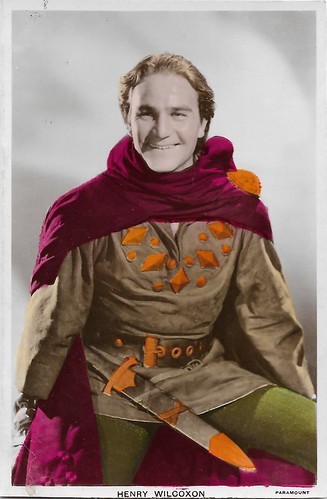
British postcard in the Colourgraph Series, no. C248. Photo: Paramount. Henry Wilcoxon as King Richard in the period piece The Crusades (Cecil B. DeMille, 1935).
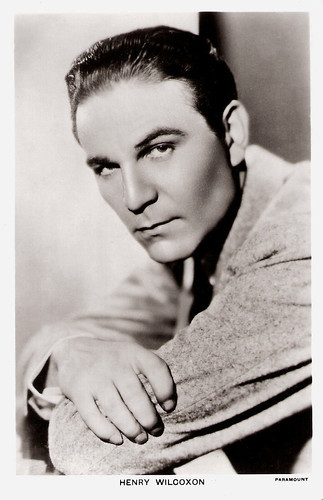
British postcard in the Picturegoer series, London, no. 863. Photo: Paramount.
Sources: The New York Times, The Scott Rollins Film and TV Trivia Blog, Wikipedia and .

French postcard by A.N., Paris, no. 963. Photo: Paramount. Henry Wilcoxon in Cleopatra (Cecil B. DeMille, 1934).

British Real Photograph postcard, no. 110. Photo: Paramount Pictures.
Ill from malnutrition and neglect
Harry Frederick Wilcoxon was born on 8 September 1905 in Roseau, Dominica, British West Indies. His father was English-born Robert Stanley 'Tan' Wilcoxon, manager of the Colonial Bank in Jamaica and his mother, Lurline Mignonette Nunes, was a Jamaican amateur theatre actress, descendant of a wealthy Spanish merchant family. His older brother was Robert 'Owen' Wilcoxon.
Henry had a difficult childhood. His mother disappeared suddenly and mysteriously when he was about a year old, and his father took him and Owen to England with the intention that his own mother Ann would take care of them. But, because his mother was too frail to care for the children, they were first sent to a foster home, where they became ill from malnutrition and neglect and they were moved on to an orphanage. There, Harry suffered from rickets, and Owen developed a stutter and had epileptic fits. They were rescued from the orphanage to a new foster home.
After several years Harry's father 'Tan', with his new wife Rosamond took the children home with them to Bridgetown, Barbados, where they were educated. Harry and Owen became known as 'Biff' and 'Bang' due to their fighting skills gained in amateur boxing. After completing his education, Wilcoxon was employed by Joseph Rank, the father of J. Arthur Rank, before working for Bond Street tailors Pope and Bradshaw. While working for the tailors, Wilcoxon applied for a visa to work as a chauffeur in the United States, but upon seeing his application refused, turned to boxing and then to acting.
His first stage performance was a supporting role in an adaptation of the novel 'The 100th Chance', by Ethel M. Dell, in 1927 at Blackpool. Wilcoxon joined the Birmingham Repertory Theatre the next year and toured for several years.
He found critical success playing Captain Cook in a production of Rudolph Besier's 'The Barretts of Wimpole Street' at the London Queen's Theatre alongside Cedric Hardwicke . In 1932, He played at the Queen's Theatre in Sir Barry Jackson's production of Beverley Nichols' novel 'Evensong' alongside Edith Evans.

Dutch postcard. Photo: Paramount. Claudette Colbert as Cleopatra and Henry Wilcoxon as Marc Anthony in Cleopatra (Cecil B. DeMille, 1934).

Dutch postcard. Photo: Paramount. Henry Wilcoxon as Marc Anthony in Cleopatra (Cecil B. DeMille, 1934).
The man-hungry Queen of Egypt
In 1931, Harry Wilcoxon made his screen debut as Larry Tindale in The Perfect Lady (Frederick J. Jackson, Milton Rosmer, 1931), followed by a role opposite Heather Angel in Self Made Lady (George King, 1932), alongside Louis Hayward. In 1932, he appeared in The Flying Squad (F.W. Kraemer, 1932), a sound remake of a 1929 silent film based on the novel by Edgar Wallace. Altogether he made eight films in Britain till 1934.
In 1933, a talent scout for Paramount Pictures arranged a screen test which came to the attention of producer-director Cecil B. DeMille in Hollywood. He cast Wilcoxon as Marc Anthony in Cleopatra (Cecil B. DeMille, 1934) opposite Claudette Colbert as the man-hungry Queen of Egypt. Harry was renamed by DeMille for the role and from then on he was Henry Wilcoxon.
He was next given the lead role of Richard the Lionhearted in DeMille's big-budget spectacle The Crusades (Cecil B. DeMille, 1935) opposite Loretta Young. That film, however, was a financial failure, losing more than $700,000. After the lack of success of The Crusades, Wilcoxon's career stalled. He starred in a number of B-films, like The President's Mystery (Phil Rosen, 1936) and Prison Nurse (James Cruze, 1938) for Republic Pictures, and he portrayed the supporting role of Maj. Duncan Heyward in the commercially successful Last of the Mohicans (George B. Seitz, 1936) starring Randolph Scott.
Wilcoxon himself called 'his worst acting job' Mysterious Mr. Moto (Norman Foster, 1938) featuring Peter Lorre . That year, he also played in If I Were King (Frank Lloyd, 1938) with Ronald Colman , and featured in Five of a Kind (Herbert I. Leeds, 1938) with the Dionne quintuplets. In Great Britain, Wilcoxon appeared as Captain Hardy in Lady Hamilton (Alexander Korda, 1941), alongside Laurence Olivier and Vivien Leigh .
When America entered the World War II in December 1941, Wilcoxon enlisted in the United States Coast Guard. He served with the Coast Guard until 1946, gaining the rank of Lieutenant. During his period of service, he had three films released in 1942, among them Mrs. Miniver (William Wyler, 1942), which received considerable public acclaim, as well as six Academy Awards. Wilcoxon, in his role as the vicar, re-wrote the key sermon with director William Wyler. The speech made such an impact that it was used in essence by President Roosevelt as a morale builder.
Upon his return from war service, Wilcoxon picked up with Cecil B. DeMille with Unconquered (Cecil B. DeMille, 1947), starring Gary Cooper . After starring as Sir Lancelot in the musical version of Mark Twain's A Connecticut Yankee in King Arthur's Court (Tay Garnett, 1949) with Bing Crosby in the title role, he featured in DeMille's Samson and Delilah (Cecil B. DeMille, 1949).
Wilcoxon returned to England to feature in The Miniver Story (H.C. Potter, 1950), a sequel to the multi-Oscar-winning Mrs. Miniver (1942) in which he reprised his role as the vicar opposite Greer Garson . In the late 1940s, young actors and actresses came to Wilcoxon and wife Joan Woodbury and asked them to form a play-reading group which in 1951 became the Wilcoxon Players.

French postcard by A.N., Paris, no. 961. Photo: Paramount. Henry Wilcoxon as Marc Anthony and Gertrude Michael as Caesar's wife Calpurnia in Cleopatra (Cecil B. DeMille, 1934).

French postcard by A.N., Paris, no. 962. Photo: Paramount. Claudette Colbert and Henry Wilcoxon in Cleopatra (Cecil B. DeMille, 1934).
The World's Greatest Showman
Henry Wilcoxon played a small but important part as FBI Agent Gregory in DeMille's The Greatest Show on Earth (Cecil B. DeMille, 1952), on which he also served as Associate Producer. The film won the Academy Award for Best Picture in 1952. He also acted as associate producer on, and acted as Pentaur, the pharaoh's captain of the guards, in DeMille's remake of his own The Ten Commandments (Cecil B. DeMille, 1956).
Wilcoxon was sole producer on The Buccaneer (Anthony Quinn, 1958), a remake of DeMille's 1938 effort, which DeMille only supervised due to his declining health while his then son-in-law Anthony Quinn directed. After DeMille died, Wilcoxon worked on a film based on the life of Lord Baden-Powell, founder of the Boy Scout movement, which DeMille had left unrealised, and was also ultimately abandoned.
After a relatively inactive period, Wilcoxon appeared with Charlton Heston in The War Lord (Franklin Schaffner, 1965). He was co-producer on the TV tribute The World's Greatest Showman: The Legend of Cecil B. DeMille (1963). At the opening of the DeMille Theatre in New York, he produced another short film.
In the last two decades of his life, he worked sporadically and accepted minor acting roles in TV shows including The Big Valley (1965), I Spy (1966), It Takes a Thief (1968), Gunsmoke (1970), Lassie (1973), Cagney & Lacey (1982), and Private Benjamin (1982). He also appeared in a few films films like F.I.S.T (Norman Jewison, 1978), starring Sylvester Stallone.
He had a memorable turn as the golf-obsessed Bishop Pickering, struck by lightning, in the slapstick comedy Caddyshack (Harold Ramis, 1980) with Bill Murray as his caddy. His final film was Sweet Sixteen - Blutiges Inferno (Jim Sotos, 1983).
By loaning money from his early film acting, Wilcoxon assisted his brother Owen to establish himself in 1931 as a partner in the Vale Motor Company in London, and for a short time he showed a personal interest in the development of their sports car, the Vale Special.
At that time his girlfriend was a London-based American stage actress Carol Goodner. Wilcoxon married 19-year-old actress Sheila Garrett in 1936, but they divorced a year later. In 1938 he married his second wife, 23-years-old actress Joan Woodbury. They had three daughters: Wendy Joan Robert Wilcoxon (born 1939), Heather Ann Wilcoxon (1947) and Cecilia Dawn 'CiCi' Wilcoxon (1950). The couple divorced in 1969. Henry Wilcoxon passed away in 1984 in Los Angeles. He was 78 years old and had been ill with cancer.

British postcard in the Colourgraph Series, no. C248. Photo: Paramount. Henry Wilcoxon as King Richard in the period piece The Crusades (Cecil B. DeMille, 1935).

British postcard in the Picturegoer series, London, no. 863. Photo: Paramount.
Sources: The New York Times, The Scott Rollins Film and TV Trivia Blog, Wikipedia and .
Published on March 26, 2020 23:00
March 25, 2020
Helga Piur
Helga Piur (1939), is a German actress and voice actress, who was very popular in the GDR thanks to her TV roles. She also appeared in DEFA films of the 1960s and 1970s. And she gave Brigitte Bardot her voice in synchronised films.
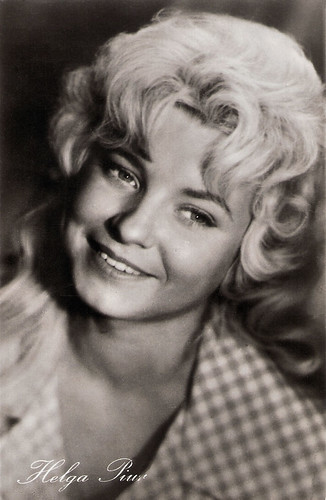
East-German postcard by VEB Progress Film-Vertrieb, Berlin, no. 1221, 1959. Photo: DEFA / Neufeld. Helga Piur in Wo der Zug nicht lange hält/Where the train does not stop long (Joachim Hassler, 1960).
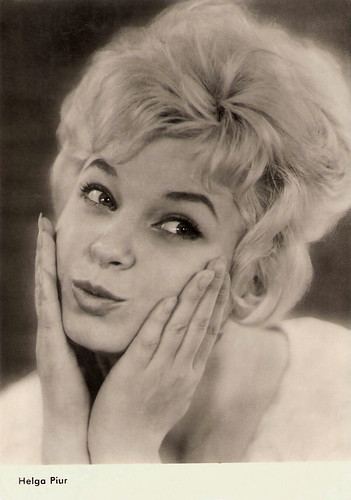
East-German postcard by VEB Progress Film-Vertrieb, Berlin, no. 1400, 1961. Photo: Jadke.
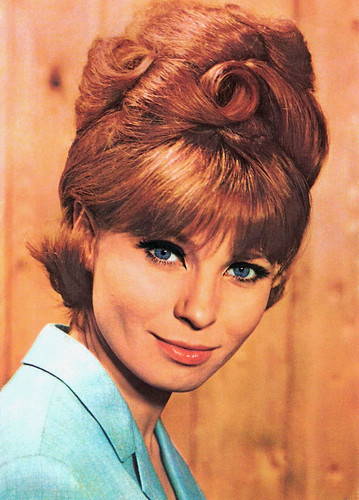
East-German postcard by VEB Progress Film-Vertrieb, Berlin, no. 2393, 1965. Photo: DEWAG / Herbst.
Das Stacheltier
Helga Piur was born in 1939 in Berlin. She was the youngest of six children. At the age of five, her mother died. Helga grew up with her father's sister and her husband.
As a child Helga sang in the radio children's choir. She later acted for a lay playgroup and was a secretary at the Dietz publishing house in Berlin. Several applications at the drama school failed. Therefore, she took private lessons with actor Eduard von Winterstein.
Since 1959, she regularly appeared on German television. First, she acted mainly in children's programs. She portrayed such popular characters as the doll Edelgard or Bastelinchen in programs such as Unser Sandmännchen/Our Sandman (1959), Bahnhof Puppenstadt/Station Puppet City or Treff mit Petra. Piur was also quickly cast in TV comedies and thrillers.
From the early 1960s, she is also engaged by the DEFA for some films, including the love story Wo der Zug nicht lange hält/Where the train does not stop long (Joachim Hassler, 1960) with Stefan Lisewski , and the musical Das Stacheltier - Der Dieb von San Marengo/The Stinging Animal - The Thief of San Marengo (Günter Reisch, 1963) with Horst Drinda. Das Stacheltier was a satirical series of short films that was produced in East Germany by the DEFA Film Studios from 1953 to 1964.
Over the next two decades, she appeared in a variety of roles in a wide variety of film genres. She was also active as a voice actress and performed for the radio.
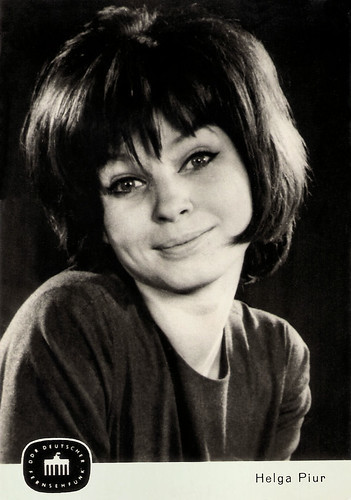
East-German postcard by VEB Bild und Heimat Reichenbach I.V., no. G 6163, 1963. Photo: DDR Deutscher Fernsehfunk / Denger, 1963.
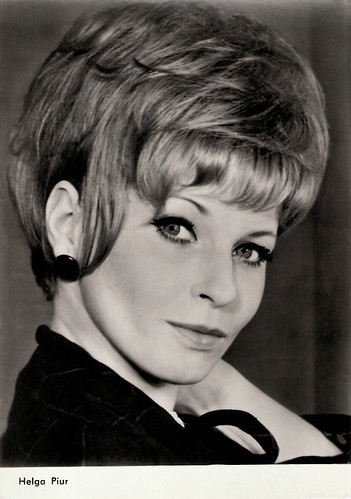
East-German postcard by VEB Progress Film-Vetrieb, Berlin, no. 2.673, 1966. Photo: DEWAG / Herbst.
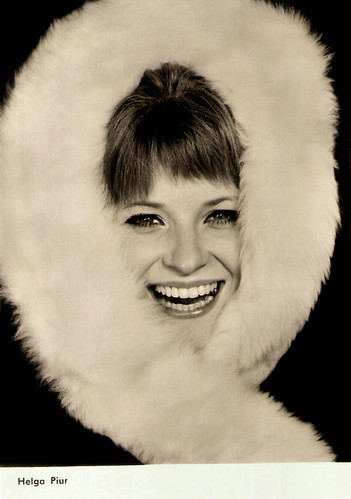
East-German postcard by VEB Progress Film-Vetrieb, Berlin, no. 27/49, 1967. Photo: DEWAG / Herbst.
A superstar in the GDR
From 1967 to 1982 Helga Piur was heard as Brigitte Neumann in most of the 678 episodes of the popular radio drama series Neumann, zweimal klingeln/Neumann, ring twice on Radio DDR I.
Her films in this period included Orpheus in der Unterwelt/Orpheus in the underworld (Horst Bonnet, 1974) with Dorit Gäbler and Rolf Hoppe .
Piur became a superstar in the GDR with the television series Zahn um Zahn/Tooth for a Tooth (1985-1988), where she portrayed the receptionist Victoria Happmeyer, called Häppchen, on the side of Alfred Struwe as the Berlin-based dentist Dr. Alexander Wittkuge.
Since 1988 Piur belonged to the permanent ensemble of the DFF, which ended however in 1991. Nevertheless, after the fall of the Berlin Wall in 1989-1990, she was often seen on television and is particularly dedicated to synchronisation work.
In the GDR, Piur was often awarded. She gave Brigitte Bardot her voice in synchronised films. Helga Piur was married to the actor Gert Andreae until his death in 1972. In 1974 she married the writer and director Günter Stahnke, with whom she was married until his death in 2018. She often appeared in his TV-films.
Helga Piur lives in Fredersdorf. She has a daughter. In 2009 her book 'Ein Häppchen von mir' (A Slice of Me) appeared. The title refers to her her most popular role, Victoria 'Häppchen' Happmeyer, in Zahn um Zahn/Tooth for a Tooth (1985-1988).
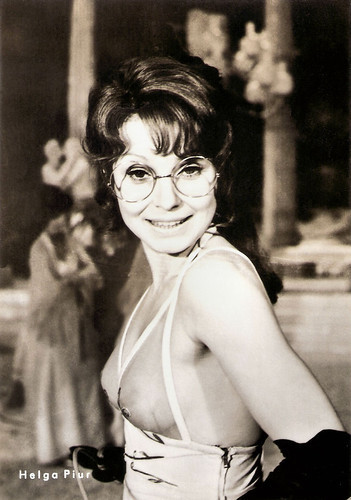
East-German postcard by VEB Progress Film-Vertrieb, Berlin, no. 161/73, 1973. Photo: DEFA. Helga Piur in Orpheus in der Unterwelt/Orpheus in the underworld (Horst Bonnet, 1974).
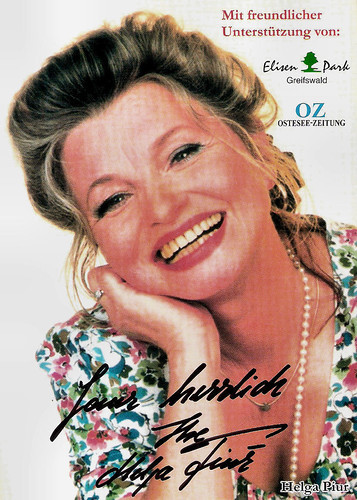
German autograph card, sponsored by Elisen Park, Greifswald and OZ Ostesee-Zeitung.
Sources: DEFA Stiftung (German), Wikipedia (German) and .

East-German postcard by VEB Progress Film-Vertrieb, Berlin, no. 1221, 1959. Photo: DEFA / Neufeld. Helga Piur in Wo der Zug nicht lange hält/Where the train does not stop long (Joachim Hassler, 1960).

East-German postcard by VEB Progress Film-Vertrieb, Berlin, no. 1400, 1961. Photo: Jadke.

East-German postcard by VEB Progress Film-Vertrieb, Berlin, no. 2393, 1965. Photo: DEWAG / Herbst.
Das Stacheltier
Helga Piur was born in 1939 in Berlin. She was the youngest of six children. At the age of five, her mother died. Helga grew up with her father's sister and her husband.
As a child Helga sang in the radio children's choir. She later acted for a lay playgroup and was a secretary at the Dietz publishing house in Berlin. Several applications at the drama school failed. Therefore, she took private lessons with actor Eduard von Winterstein.
Since 1959, she regularly appeared on German television. First, she acted mainly in children's programs. She portrayed such popular characters as the doll Edelgard or Bastelinchen in programs such as Unser Sandmännchen/Our Sandman (1959), Bahnhof Puppenstadt/Station Puppet City or Treff mit Petra. Piur was also quickly cast in TV comedies and thrillers.
From the early 1960s, she is also engaged by the DEFA for some films, including the love story Wo der Zug nicht lange hält/Where the train does not stop long (Joachim Hassler, 1960) with Stefan Lisewski , and the musical Das Stacheltier - Der Dieb von San Marengo/The Stinging Animal - The Thief of San Marengo (Günter Reisch, 1963) with Horst Drinda. Das Stacheltier was a satirical series of short films that was produced in East Germany by the DEFA Film Studios from 1953 to 1964.
Over the next two decades, she appeared in a variety of roles in a wide variety of film genres. She was also active as a voice actress and performed for the radio.

East-German postcard by VEB Bild und Heimat Reichenbach I.V., no. G 6163, 1963. Photo: DDR Deutscher Fernsehfunk / Denger, 1963.

East-German postcard by VEB Progress Film-Vetrieb, Berlin, no. 2.673, 1966. Photo: DEWAG / Herbst.

East-German postcard by VEB Progress Film-Vetrieb, Berlin, no. 27/49, 1967. Photo: DEWAG / Herbst.
A superstar in the GDR
From 1967 to 1982 Helga Piur was heard as Brigitte Neumann in most of the 678 episodes of the popular radio drama series Neumann, zweimal klingeln/Neumann, ring twice on Radio DDR I.
Her films in this period included Orpheus in der Unterwelt/Orpheus in the underworld (Horst Bonnet, 1974) with Dorit Gäbler and Rolf Hoppe .
Piur became a superstar in the GDR with the television series Zahn um Zahn/Tooth for a Tooth (1985-1988), where she portrayed the receptionist Victoria Happmeyer, called Häppchen, on the side of Alfred Struwe as the Berlin-based dentist Dr. Alexander Wittkuge.
Since 1988 Piur belonged to the permanent ensemble of the DFF, which ended however in 1991. Nevertheless, after the fall of the Berlin Wall in 1989-1990, she was often seen on television and is particularly dedicated to synchronisation work.
In the GDR, Piur was often awarded. She gave Brigitte Bardot her voice in synchronised films. Helga Piur was married to the actor Gert Andreae until his death in 1972. In 1974 she married the writer and director Günter Stahnke, with whom she was married until his death in 2018. She often appeared in his TV-films.
Helga Piur lives in Fredersdorf. She has a daughter. In 2009 her book 'Ein Häppchen von mir' (A Slice of Me) appeared. The title refers to her her most popular role, Victoria 'Häppchen' Happmeyer, in Zahn um Zahn/Tooth for a Tooth (1985-1988).

East-German postcard by VEB Progress Film-Vertrieb, Berlin, no. 161/73, 1973. Photo: DEFA. Helga Piur in Orpheus in der Unterwelt/Orpheus in the underworld (Horst Bonnet, 1974).

German autograph card, sponsored by Elisen Park, Greifswald and OZ Ostesee-Zeitung.
Sources: DEFA Stiftung (German), Wikipedia (German) and .
Published on March 25, 2020 23:00
March 24, 2020
Paname...n'est pas Paris (1927)
Paname...n'est pas Paris/Die Apachen von Paris/Apaches of Paris (Nikolai Malikoff, 1927) was a French silent crime drama, supervised by maestro Marcel L'Herbier. His protege Jaque Catelain plays a young street gangster, who is torn between a good and a bad woman. The French press labelled these criminals in Paris 'Apaches' because of their savage violence. They became a fad, especially after the Apache dance conquered the world.
French postcard by Cinémagazine-Edition, Paris, no. 543. Photo: Jaque Catelain and Ruth Weyer in Paname...n'est pas Paris/Die Apachen von Paris (Nikolai Malikoff, 1927).
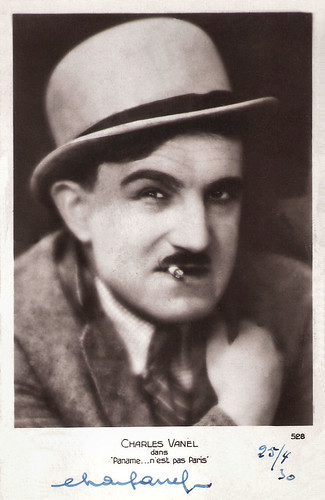
French postcard by Cinémagazine-Edition, Paris, no. 528. Photo: Charles Vanel in Paname...n'est pas Paris/Die Apachen von Paris (Nikolai Malikoff, 1927). Signed by Vanel at 25 April 1930.
French postcard by Cinémagazine-Edition, no. 527. Lia Eibenschutz in Paname...n'est pas Paris/ Die Apachen von Paris (Nikolai Malikoff, 1927).
A fire in the editing room
In Paname...n'est pas Paris/ Die Apachen von Paris (Nikolai Malikoff, 1927), Jaque Catelain plays the young Milord who is part of a gang of criminals as well as his companion, Mama Savonette ( Ruth Weyher ).
Milord is under the spell of Winnie Rowlandson (Lia Eibenschütz) and hesitates to steal her bracelet. He plans to make amends, but becoming an honest boy is more difficult than Milord supposes...
The cast was a mix of French and German actors. Mylord's opponent, the Apache Bécot, was played by the great Charles Vanel . Other actors were the Frenchman Bondy, and from Germany Olga Limburg and Jakob Tiedtke.
Director of the film was the Russian director Nikolai Malikoff, assisted by Georges Lampin. The famous French director Marcel L'Herbier was the producer supervisor. The film's art direction was done by the later film director Claude Autant-Lara and Vladimir Meingard.
The Franco-German co-production, by L'Alliance Cinématographique Européenne (ACE) and the Ufa, had a difficult production history. According to Cinémagazine, a fire broke out on Thursday 31 July 1927 in the editing room of the G. M. Film factory in Billancourt, where the film was being developed.
At the time of the fire, the film had just been finished. The producers decided to re-shoot the film completely. The German premiere took place on 17 December 1927 in Berlin at the Gloria-Palast cinema. The French premiere was on 17 February 1928.
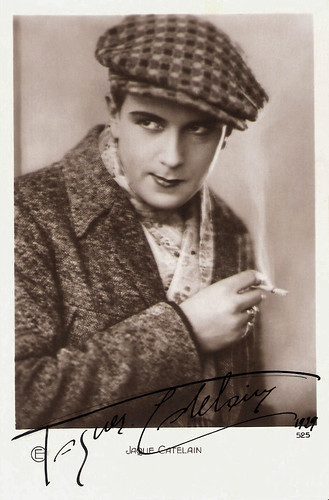
French postcard by Cinémagazine-Edition, no. 525. Signed by Jaque Catelain in 1929.
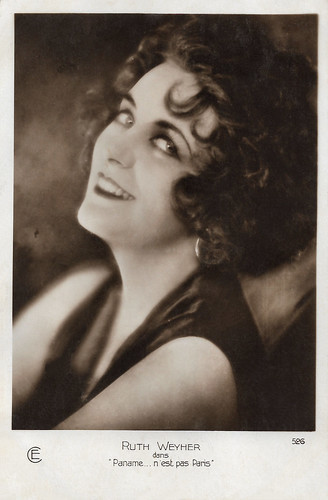
French postcard by Cinémagazine-Edition, no. 526. Ruth Weyher in Paname...n'est pas Paris/Die Apachen von Paris (Nikolai Malikoff, 1927).
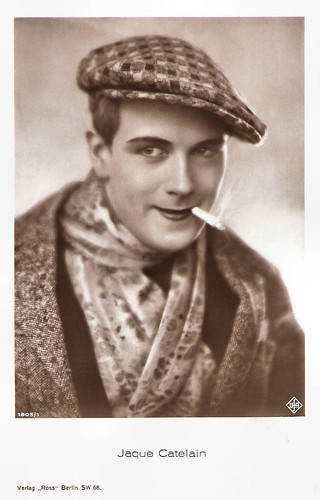
German postcard by Ross Verlag, no. 1805/1, 1927-1928. Photo: Ufa.
Paname and the Apaches
'Paname' is the 'argot' (slang) name for Paris and its suburbs. But there is a difference between the two. Paname is the hidden Paris, the dark and dangerous Paris of the criminals and the prostitutes. During the First World War, the term took off and was used in songs.
'Apache' literally refers to the Native American Apache tribe, but had the additional meaning in French of a Paris street gangster. After a particularly heinous crime in 1902, the newspaper reporter Authur Dupin wrote the headline "Crime Committed by the Apaches of Belleville," referring to the perceived savagery of the American Indians described in James Fenimore Cooper novels, popular at that time. The French pronounce it "a-PAHSH", and the term stuck.
In 1900, the name was also taken up by a group of young artists including the composers Claude Debussy, Manuel de Falla, and Maurice Ravel. Inadvertently they bumped once into a newspaper seller who exclaimed "Attention les apaches". They soon adapted the name, which Ravel suggested that they adopt the first melody of Borodin's 2nd Symphony as their theme, an idea with which they all agreed. The group met each Saturday and rallied around Claude Debussy's opera 'Pelléas et Mélisande' at and after its controversial premiere.
The young Apaches of Montmartre, Belleville and the Barrières swaggered with an arrogant pride, dressed distinctively and were handy with a knife. In 1908, American dancer Maurice Mouvet and French actor and dancer Max Dearly began to visit the low bars frequented by Apaches in a search for inspiration for new dances. They formulated the new dance from moves seen there and gave to it the name Apache, according to Wikipedia and other sources. Max Dearly first performed it in 1908 in Paris at the Ambassadeurs and Maurice in Ostend at the Kursaal. A short while later, in the summer of 1908, Maurice and his partner Leona performed the dance at Maxim's, and Max Dearly made an even bigger impact with it, partnered with Mistinguett, in the Moulin Rouge show, 'La Revue du Moulin'.
However, Mistinguett later claimed that she had invented the Apache dance. Who was right? Dance historian Richard Powers wrote an interesting article about the history of the Apache dance. Powers: "with a Mr. Paulo as her partner, Mistinguett took the low-class hugging a step further, and invented 'The Cake Walk of the Barrières', which was a mock fight-as-dance between a hooligan from the low-class Barrières, and his woman. This new dance was described, with photos, in the same 1903 issue of Paris qui Chante. The illustrations show the street thug violently threatening the woman, and pulling her by her hair. The article described the dance as "vulgar and amazing at the same time." Like her 'Cake-Walk Parisien', this mock battle was an entertainment, a fiction. Mistinguett never stated that there was any prototype of men choreographically abusing women in reality. This dance also went by another name, 'La Valse Chaloupee', or 'Swaying Waltz', and later as 'La danse du Pavé', 'Danse Apache' and 'Valse Apache'."
So Mistinguett created the Apache dance, five years before she partnered Max Dearly at the Moulin Rouge. The Apache dance reenacts a violent 'discussion' between an Apache, a pimp and a gigolette, a young prostitute. It includes mock slaps and punches, the man picking up and throwing the woman to the ground, or lifting and carrying her while she struggles or feigns unconsciousness. Thus, the dance shares many features with the theatrical discipline of stage combat. In some versions of the dance, the woman may fight back. The Apache remained a popular cabaret act through the 1960s.
The Apaches also figured in early French films, such as in Georges Mélies' short comedy Les Apaches (1904). The famous French film serial Les Vampires (Louis Feuillade, 1915) about the Apache gang called 'Les Vampires' contains a number of Apache dance scenes. A notable detail is that during a part of the waltz the man holds firmly onto the woman's hair, rather than her body. Apache dances also figured in many international films. And in Paname...n'est pas Paris/Die Apachen von Paris (Nikolai Malikoff, 1927).

Mistinguett and Max Dearly . French postcard by F.C. & Cie, no. 283. Photo: Boyer & Bert. Collection: Didier Hanson.
French postcard by Cinémagazine-Edition, Paris, no. 528. Photo: Charles Vanel in Paname...n'est pas Paris/Die Apachen von Paris (Nikolai Malikoff, 1927).
Excerpt from Paname...n'est pas Paris/Die Apachen von Paris (Nikolai Malikoff, 1927). Source: Maximilian Guth (YouTube).
Sources: Richard Powers (The hidden story of the Apache dance), Wikipedia (English and English) and IMDb.
French postcard by Cinémagazine-Edition, Paris, no. 543. Photo: Jaque Catelain and Ruth Weyer in Paname...n'est pas Paris/Die Apachen von Paris (Nikolai Malikoff, 1927).

French postcard by Cinémagazine-Edition, Paris, no. 528. Photo: Charles Vanel in Paname...n'est pas Paris/Die Apachen von Paris (Nikolai Malikoff, 1927). Signed by Vanel at 25 April 1930.
French postcard by Cinémagazine-Edition, no. 527. Lia Eibenschutz in Paname...n'est pas Paris/ Die Apachen von Paris (Nikolai Malikoff, 1927).
A fire in the editing room
In Paname...n'est pas Paris/ Die Apachen von Paris (Nikolai Malikoff, 1927), Jaque Catelain plays the young Milord who is part of a gang of criminals as well as his companion, Mama Savonette ( Ruth Weyher ).
Milord is under the spell of Winnie Rowlandson (Lia Eibenschütz) and hesitates to steal her bracelet. He plans to make amends, but becoming an honest boy is more difficult than Milord supposes...
The cast was a mix of French and German actors. Mylord's opponent, the Apache Bécot, was played by the great Charles Vanel . Other actors were the Frenchman Bondy, and from Germany Olga Limburg and Jakob Tiedtke.
Director of the film was the Russian director Nikolai Malikoff, assisted by Georges Lampin. The famous French director Marcel L'Herbier was the producer supervisor. The film's art direction was done by the later film director Claude Autant-Lara and Vladimir Meingard.
The Franco-German co-production, by L'Alliance Cinématographique Européenne (ACE) and the Ufa, had a difficult production history. According to Cinémagazine, a fire broke out on Thursday 31 July 1927 in the editing room of the G. M. Film factory in Billancourt, where the film was being developed.
At the time of the fire, the film had just been finished. The producers decided to re-shoot the film completely. The German premiere took place on 17 December 1927 in Berlin at the Gloria-Palast cinema. The French premiere was on 17 February 1928.

French postcard by Cinémagazine-Edition, no. 525. Signed by Jaque Catelain in 1929.

French postcard by Cinémagazine-Edition, no. 526. Ruth Weyher in Paname...n'est pas Paris/Die Apachen von Paris (Nikolai Malikoff, 1927).

German postcard by Ross Verlag, no. 1805/1, 1927-1928. Photo: Ufa.
Paname and the Apaches
'Paname' is the 'argot' (slang) name for Paris and its suburbs. But there is a difference between the two. Paname is the hidden Paris, the dark and dangerous Paris of the criminals and the prostitutes. During the First World War, the term took off and was used in songs.
'Apache' literally refers to the Native American Apache tribe, but had the additional meaning in French of a Paris street gangster. After a particularly heinous crime in 1902, the newspaper reporter Authur Dupin wrote the headline "Crime Committed by the Apaches of Belleville," referring to the perceived savagery of the American Indians described in James Fenimore Cooper novels, popular at that time. The French pronounce it "a-PAHSH", and the term stuck.
In 1900, the name was also taken up by a group of young artists including the composers Claude Debussy, Manuel de Falla, and Maurice Ravel. Inadvertently they bumped once into a newspaper seller who exclaimed "Attention les apaches". They soon adapted the name, which Ravel suggested that they adopt the first melody of Borodin's 2nd Symphony as their theme, an idea with which they all agreed. The group met each Saturday and rallied around Claude Debussy's opera 'Pelléas et Mélisande' at and after its controversial premiere.
The young Apaches of Montmartre, Belleville and the Barrières swaggered with an arrogant pride, dressed distinctively and were handy with a knife. In 1908, American dancer Maurice Mouvet and French actor and dancer Max Dearly began to visit the low bars frequented by Apaches in a search for inspiration for new dances. They formulated the new dance from moves seen there and gave to it the name Apache, according to Wikipedia and other sources. Max Dearly first performed it in 1908 in Paris at the Ambassadeurs and Maurice in Ostend at the Kursaal. A short while later, in the summer of 1908, Maurice and his partner Leona performed the dance at Maxim's, and Max Dearly made an even bigger impact with it, partnered with Mistinguett, in the Moulin Rouge show, 'La Revue du Moulin'.
However, Mistinguett later claimed that she had invented the Apache dance. Who was right? Dance historian Richard Powers wrote an interesting article about the history of the Apache dance. Powers: "with a Mr. Paulo as her partner, Mistinguett took the low-class hugging a step further, and invented 'The Cake Walk of the Barrières', which was a mock fight-as-dance between a hooligan from the low-class Barrières, and his woman. This new dance was described, with photos, in the same 1903 issue of Paris qui Chante. The illustrations show the street thug violently threatening the woman, and pulling her by her hair. The article described the dance as "vulgar and amazing at the same time." Like her 'Cake-Walk Parisien', this mock battle was an entertainment, a fiction. Mistinguett never stated that there was any prototype of men choreographically abusing women in reality. This dance also went by another name, 'La Valse Chaloupee', or 'Swaying Waltz', and later as 'La danse du Pavé', 'Danse Apache' and 'Valse Apache'."
So Mistinguett created the Apache dance, five years before she partnered Max Dearly at the Moulin Rouge. The Apache dance reenacts a violent 'discussion' between an Apache, a pimp and a gigolette, a young prostitute. It includes mock slaps and punches, the man picking up and throwing the woman to the ground, or lifting and carrying her while she struggles or feigns unconsciousness. Thus, the dance shares many features with the theatrical discipline of stage combat. In some versions of the dance, the woman may fight back. The Apache remained a popular cabaret act through the 1960s.
The Apaches also figured in early French films, such as in Georges Mélies' short comedy Les Apaches (1904). The famous French film serial Les Vampires (Louis Feuillade, 1915) about the Apache gang called 'Les Vampires' contains a number of Apache dance scenes. A notable detail is that during a part of the waltz the man holds firmly onto the woman's hair, rather than her body. Apache dances also figured in many international films. And in Paname...n'est pas Paris/Die Apachen von Paris (Nikolai Malikoff, 1927).

Mistinguett and Max Dearly . French postcard by F.C. & Cie, no. 283. Photo: Boyer & Bert. Collection: Didier Hanson.
French postcard by Cinémagazine-Edition, Paris, no. 528. Photo: Charles Vanel in Paname...n'est pas Paris/Die Apachen von Paris (Nikolai Malikoff, 1927).
Excerpt from Paname...n'est pas Paris/Die Apachen von Paris (Nikolai Malikoff, 1927). Source: Maximilian Guth (YouTube).
Sources: Richard Powers (The hidden story of the Apache dance), Wikipedia (English and English) and IMDb.
Published on March 24, 2020 16:46
March 23, 2020
Lucia Bosé (1931-2020)
Yesterday, 23 March 2020, Italian actress Lucia Bosé passed away in Brieva, Spain. She died of pneumonia caused by the coronavirus (COVID-19). Bosé was famous for her films from the 1950s with a.o. Giuseppe De Santis and Michelangelo Antonioni. In the same years and after, she also worked with other famous directors such as Juan Bardem, Luis Buñuel, the Taviani brothers, Liliane Cavani, Francesco Rosi, and Ferzan Özpetek. Lucia Bosé was 89.
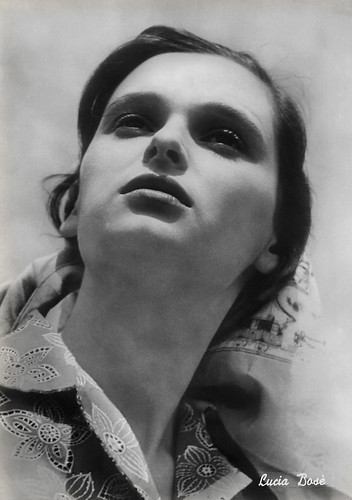
Italian postcard by Bromofoto, Milano, no. 270.
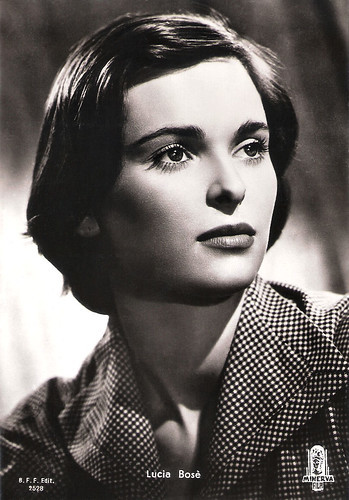
Italian postcard by Ballerini & Fratini Editori, Firenze, no. 2528. Photo: Minerva Film.
Miss Italy
Lucia Bosè was born Lucia Borloni in Milan, Italy in 1931. She came from a peasant and working-class family and began to work at the age of twelve years. First, she was a messenger for a law firm, later a clerk in Milan's fine pastry shop Galli.
In 1947 she participated in the first Miss Italy pageant, where she was able to win against competitors like Gianna Maria Canale , Eleonora Rossi Drago , and Gina Lollobrigida .
Giuseppe De Santis had preferred Silvana Mangano for Riso amaro/Bitter Rice (1949), but he chose Bosè for his next film, Non c'è pace tra gli ulivi/No peace among the olive trees (Giuseppe De Santis, 1950), a typical Neorealist film about a poor shepherd ( Raf Vallone ) who tries steal back his sheep stolen from him while he was at war.
In the same year, Bosé starred opposite Massimo Girotti in the well-to-do set, modernist crime story and drama Cronaca di un amore/Story of a love affair (Michelangelo Antonioni, 1950). It was Antonioni's first full-length feature film, about an adulterous couple plotting to kill her husband.
Numerous screen engagements followed. Antonioni cast her again in La signora senza camelie/The Lady Without Camelias (Michelangelo Antonioni, 1953) about a newly discovered starlet and her experiences in the Italian cinema. Juan Bardem cast her in Muerte di un ciclista/Death of a Cyclist (1955) about an adulterous couple that runs over a cyclist and leaves him to die. Bosé also acted in Francesco Maselli's debut Gli sbandati/The Abandoned (1955) and Luis Buñuel's Cela s'appelle l'aurore/That Is the Dawn (1956).
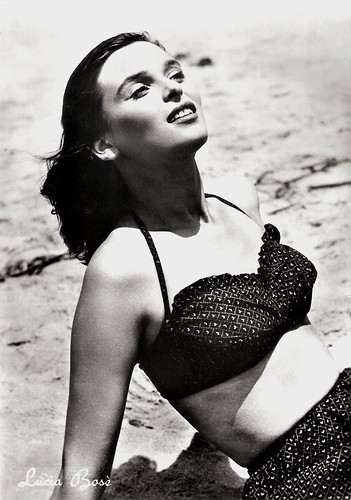
Italian postcard by Rotalfoto, Milano, no. 295.
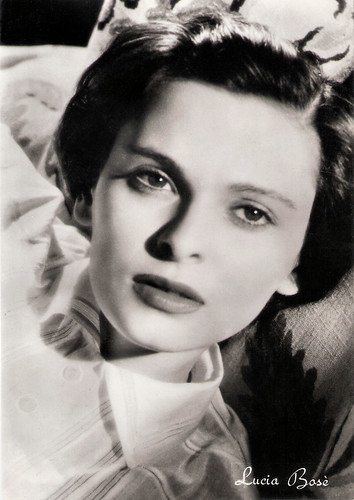
Italian postcard by Italfoto, no. 162.
Bullfighter
In 1955, Lucia Bosè married Luis Miguel Dominguín, a popular Spanish bullfighter and occasional actor. From the marriage, which ended in divorce in 1967, sprang three children, two of whom - Paola Dominguin and Miguel Bosé - are also active as actors. Luchino Visconti was godfather to her son Miguel, Pablo Picasso to her daughter Paola.
At the time, Lucia Bosè lived in Spain and put her career on halt, except for a sporadic appearance in Le testament d'Orphée/Testament of Orpheus (Jean Cocteau, 1959).
In 1968, Bosé returned to film acting after almost a ten-year break and worked first in Spain and afterward in Italy. There she worked among others in Federico Fellini's Satyricon (1969), the Taviani Brothers' Sotto il segno dello scorpione/Under the Sign of Scorpio (1969), and Liliana Cavani's L'ospite/The Guest (1972).
Other interesting films with her were Nathalie Granger (Marguerite Duras, 1972), Lumière (Jeanne Moreau, 1976), and Violanta (Daniel Schmid, 1977).
After 1978, she acted significantly less but remained active, also on television. She had memorable film performances in Cronaca di una morte annunciata/Chronicle of a Death Foretold (Francesco Rosi, 1987) starring Rupert Everett , El niño de la Luna/Moon Child (Agustí Villaronga, 1989), Harem suaré/Harem (Ferzan Özpetek, 1999) and I vicerè/The Viceroy (Roberto Faenza, 2007).
Her last screen appearance was in Alfonsina y el mar/One more time (Pablo Benedetti, David Sordella, 2013), as an 80-year-old actress who returns to the small Chilean town of her youth to fulfill her father's dream of creating a TV channel in a place which has never known television.
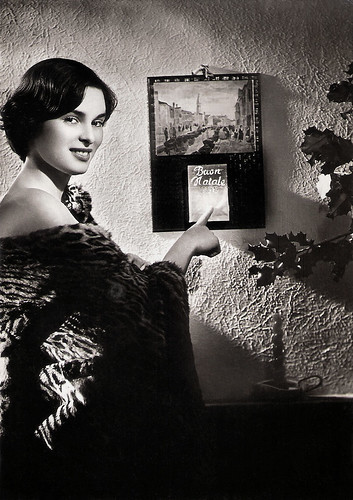
Italian postcard by Italfoto, Terni. Photo: Vedeo.
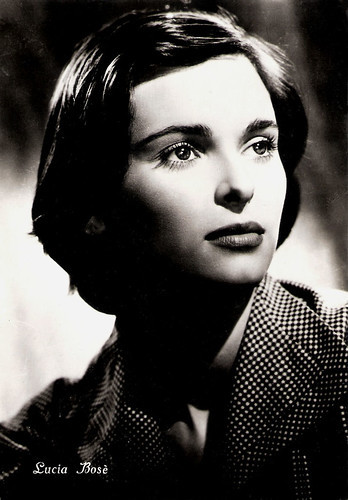
Italian postcard in the series 'Divi del Cinema' by Vetta Traldi, Milano, no. 7.
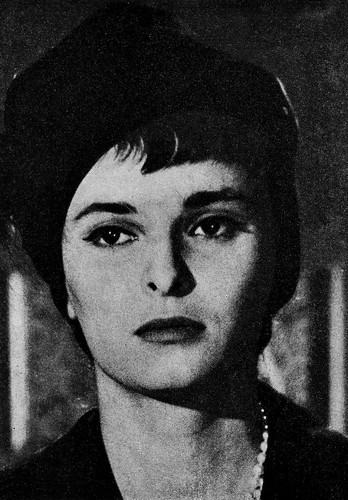
Spanish collectors card by Tarjetas Florita, no. 102. The cards were included with the magazine Revista Florita.
Sources: Wikipedia (German, English, and Italian) and .

Italian postcard by Bromofoto, Milano, no. 270.

Italian postcard by Ballerini & Fratini Editori, Firenze, no. 2528. Photo: Minerva Film.
Miss Italy
Lucia Bosè was born Lucia Borloni in Milan, Italy in 1931. She came from a peasant and working-class family and began to work at the age of twelve years. First, she was a messenger for a law firm, later a clerk in Milan's fine pastry shop Galli.
In 1947 she participated in the first Miss Italy pageant, where she was able to win against competitors like Gianna Maria Canale , Eleonora Rossi Drago , and Gina Lollobrigida .
Giuseppe De Santis had preferred Silvana Mangano for Riso amaro/Bitter Rice (1949), but he chose Bosè for his next film, Non c'è pace tra gli ulivi/No peace among the olive trees (Giuseppe De Santis, 1950), a typical Neorealist film about a poor shepherd ( Raf Vallone ) who tries steal back his sheep stolen from him while he was at war.
In the same year, Bosé starred opposite Massimo Girotti in the well-to-do set, modernist crime story and drama Cronaca di un amore/Story of a love affair (Michelangelo Antonioni, 1950). It was Antonioni's first full-length feature film, about an adulterous couple plotting to kill her husband.
Numerous screen engagements followed. Antonioni cast her again in La signora senza camelie/The Lady Without Camelias (Michelangelo Antonioni, 1953) about a newly discovered starlet and her experiences in the Italian cinema. Juan Bardem cast her in Muerte di un ciclista/Death of a Cyclist (1955) about an adulterous couple that runs over a cyclist and leaves him to die. Bosé also acted in Francesco Maselli's debut Gli sbandati/The Abandoned (1955) and Luis Buñuel's Cela s'appelle l'aurore/That Is the Dawn (1956).

Italian postcard by Rotalfoto, Milano, no. 295.

Italian postcard by Italfoto, no. 162.
Bullfighter
In 1955, Lucia Bosè married Luis Miguel Dominguín, a popular Spanish bullfighter and occasional actor. From the marriage, which ended in divorce in 1967, sprang three children, two of whom - Paola Dominguin and Miguel Bosé - are also active as actors. Luchino Visconti was godfather to her son Miguel, Pablo Picasso to her daughter Paola.
At the time, Lucia Bosè lived in Spain and put her career on halt, except for a sporadic appearance in Le testament d'Orphée/Testament of Orpheus (Jean Cocteau, 1959).
In 1968, Bosé returned to film acting after almost a ten-year break and worked first in Spain and afterward in Italy. There she worked among others in Federico Fellini's Satyricon (1969), the Taviani Brothers' Sotto il segno dello scorpione/Under the Sign of Scorpio (1969), and Liliana Cavani's L'ospite/The Guest (1972).
Other interesting films with her were Nathalie Granger (Marguerite Duras, 1972), Lumière (Jeanne Moreau, 1976), and Violanta (Daniel Schmid, 1977).
After 1978, she acted significantly less but remained active, also on television. She had memorable film performances in Cronaca di una morte annunciata/Chronicle of a Death Foretold (Francesco Rosi, 1987) starring Rupert Everett , El niño de la Luna/Moon Child (Agustí Villaronga, 1989), Harem suaré/Harem (Ferzan Özpetek, 1999) and I vicerè/The Viceroy (Roberto Faenza, 2007).
Her last screen appearance was in Alfonsina y el mar/One more time (Pablo Benedetti, David Sordella, 2013), as an 80-year-old actress who returns to the small Chilean town of her youth to fulfill her father's dream of creating a TV channel in a place which has never known television.

Italian postcard by Italfoto, Terni. Photo: Vedeo.

Italian postcard in the series 'Divi del Cinema' by Vetta Traldi, Milano, no. 7.

Spanish collectors card by Tarjetas Florita, no. 102. The cards were included with the magazine Revista Florita.
Sources: Wikipedia (German, English, and Italian) and .
Published on March 23, 2020 23:00
March 22, 2020
Sebastian Koch
Sebastian Koch (1962) is one of Germany s most multi-faceted and successful television and film actors. He is known for roles in the Academy Award-winning film The Lives of Others (2007), Paul Verhoeven’s Zwartboek/Black Book (2006), Steven Spielberg’s Bridge of Spies (2015), and as Otto Düring in the fifth season of the TV series Homeland (2015-2016). Recently, he could be seen in Werk ohne Autor/Never Look Away (2018) with Tom Schilling, and in the TV adaptation of Umberto Eco's novel The Name of the Rose (2019) with John Turturro and Rupert Everett. Announced is the Canadian series Shadowplay (2020), in which he will star with Nina Hoss.
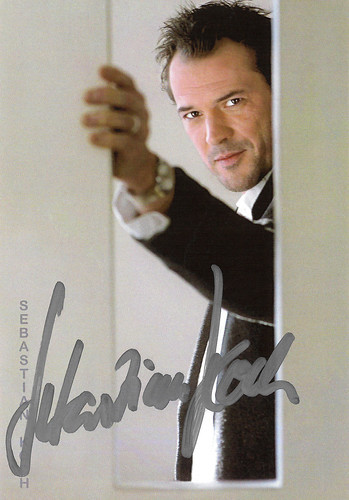
German autograph card. Photo: Ruth Kappus, München.
TV event of the year
Sebastian Koch was born in 1962 in Karlsruhe, West Germany. Koch grew up in Stuttgart with his single mother and temporarily lived in the orphanage where his mother worked.
He originally wanted to be a musician, but a production of the artistic director Claus Peymann influenced him in the late 1970s to change his career aspiration to become an actor. From 1982 to 1985, Koch studied acting at the renowned Otto-Falckenberg-Schule (Otto Falckenberg School) in Munich.
In addition to his cinematic work, he played a diversity of different roles on stage. Koch portrayed amongst other 'Peer Gynt' and Leonce in 'Leonce and Lena' at the municipal theatre of Darmstadt. At the Schiller Theater in Berlin, he played the character Roller in Schiller's 'Die Raüber' (The Robbers) and Orest in Goethe's 'Iphigenie auf Tauris'. A couple of years later, he took over the role of Lord Goring in Oscar Wilde's 'An Ideal Husband' at the playhouse Bochum under the direction of Armin Holz.
Koch had his first TV appearance in 1980 in the 77th episode of the Krimi series Derrick, followed by an episode in another popular Krimi series Tatort/Crime Scene (1986). He acted in numerous thrillers like Der Mann mit der Maske/The Man with the Mask (Peter Schulze-Rohr, 1994), Die brennende Schnecke/The Burning Snail (Thomas Stiller, 1996) and in Heinrich Breloer's two-piece Todesspiel/Dead Pool (1997), in which he portrayed the role of Andreas Baader. This role overnight changed his career.
Sebastian Koch won in 2002 the Adolf Grimme Award for two different films, a feat not achieved in over 30 years of German television. He won the award for the title role in Der Tanz mit dem Teufel - Die Entfuehrung des Richard Oetker/Dance with the Devil – The Kidnapping of Richard Oetker (Peter Keglevic, 2001), the story of the abduction of the heir to the Oetker fortune, and for his performance as the writer Klaus Mann in the three-part historical family drama Die Manns - Ein Jahrhundertroman/The Manns – A Novel of the Century (Heinrich Breloer, 2002), starring Armin Mueller-Stahl as Thomas Mann. The latter drama was furthermore distinguished as "TV event of the year" with the German Television Award, and Koch received the Bavarian TV Award for the same film.

German autograph card. Photo: Mathias Bothor.
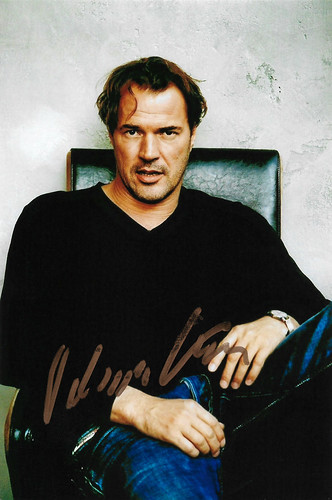
German autograph card.
An extremely intense examination of German History
One of Sebastian Koch's first international productions was the historical drama Napoléon/Napoleon (Yves Simoneau, 2002), in which he appeared alongside Christian Clavier, Gérard Depardieu , John Malkovich and Isabella Rossellini. He also portrayed Rodolphe Löwenstein, the youthful lover of Catherine Deneuve in Princesse Marie/Marie und Freud (Benoît Jacquot, 2004).
Anke Zindler at IMDb: 'Koch' s continued choice of roles in his career have provided an extremely intense examination of many personalities and themes pertaining to German history.' He played Rudolf Höss in Costa-Gavras' Hochhuth adaptation Amen (2002). He appeared in The Tunnel (Roland Suso Richter, 2001), a made-for-television German film about the idea of going underground by digging a tunnel shortly after the construction of the Berlin wall in 1961, and in the historical drama Zwei Tage Hoffnung/Two Days of Hope (Peter Keglevic, 2003) about the strike in the GDR on 17 June 1953.
Koch appeared as Oberst Claus Graf Schenk von Stauffenberg in Stauffenberg/Operation Valkryrie (Jo Baier, 2004) winner of the German Film Award; and as the Nazi architect Albert Speer in the TV mini series Speer und Er/Speer & Hitler: The Devil's Architect (Heinrich Breoler, 2005) - his third collaboration with director Heinrich Breoler, following Todesspiel/Dead Pool (1997) and Die Manns - Ein Jahrhundertroman/The Manns – A Novel of the Century (2002). He received for his latter performance the German TV Award.
In 2006, Sebastian Koch played his most famous role as GDR dramatist/playwright Georg Dreymann in the drama Das Leben der Anderen/The Lives of Others (Florian Henckel von Donnersmarck, 2006) opposite Ulrich Mühe and Martine Gedeck. Dreyman was an East-German dissident who was spied on and monitored by the Stasi. The film received an Oscar for Best Foreign Language Film in 2007 as well as the BAFTA Award, the César, and the German and European Film Award.
In Paul Verhoeven’s excellent film Zwartboek/Black Book (2006), Koch played a Nazi Officer in occupied Holland who falls in love with a Jewish member of the resistance ( Carice van Houten ). Black Book celebrated its premiere at the Venice Film Festival and the Toronto International Film Festival.
Koch appeared opposite Tim Roth in the international production of Jack London’s classic psychological adventure novel Sea Wolf (Mike Barker, 2008). He portrayed a lonely despot of both brutal cruelty and longing romance. The shooting of this two-parter based on Nigel Williams’ script took place in Halifax, Canada. The mini-series won the Directors Guild of Canada Award and Koch was nominated in 2010 for his role as Wolf Larsen for the international Emmy Award. In Manipulation (Pascal Verdosci, 2009), adapted from the novel 'Das Verhör des Harry Wind', Koch played a leading role opposite Klaus Maria Brandauer.
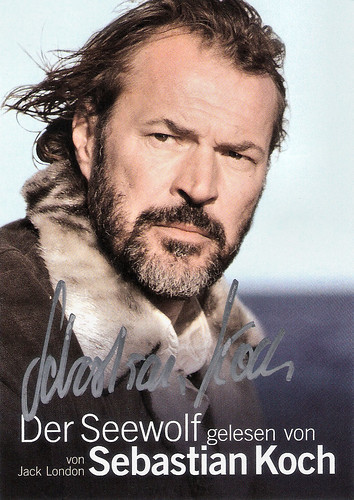
German promotion card for the audiobook Der Seewolf/The Sea-Wolf (2009), by Jack London, read by Sebastian Koch.
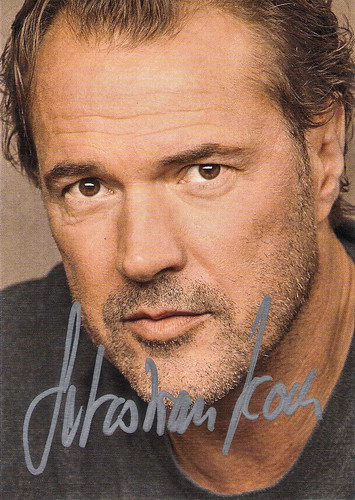
German autograph card. Photo: Thomas Leidig.
The first feature film to address the Nazis' euthanasia program
Sebastian Koch also starred in the English independent tragicomedy Albatross (Niall MacCormick, 2010), Unknown (Jaume Collet-Serra, 2010) with Liam Neeson and Diane Kruger, and he had a guest role alongside Eva Green and Joseph Fiennes in the TV series Camelot (2011). In 2011, Koch also appeared in the Czech production Ve Stinu/The Shadow of the Horse (David Ondricek, 2012), in which he played the leading role of the investigator Zenk, whose mission is to win through one personal rival and through the regime of communist Prague in the 1950s.
In Das Wochenende/The Weekend (Nina Grosse, 2012), Koch portrays an amnestied RAF terrorist (Jens Kessler), who has a reunion with his old mates. In the same year, Koch made the Greek-Russian drama film O Theos agapaei to haviari/God Loves Caviar (Yannis Smaragdis, 2012), based upon the true story of Ioannis Varvakis, played by Koch, a former pirate who moved up to being a Greek caviar merchant and eventual benefactor from Psara. The international cast also included Catherine Deneuve as Catherine the Great of Russia and John Cleese as Officer McCormick.
Furthermore, Koch played the title role in the thriller Suspension of Disbelief (Mike Figgis, 2012) with Lotte Verbeek, and was Bruce Willis’ Russian antagonist in A Good Day to Die Hard (John Moore, 2013), part 5 of the Die Hard films. Ridley Scott directed him in The Vatican (2013), a pilot episode for a Showtime series about intrigues concerning the Pope and mysteries and secrets within the Catholic Church. Koch played the role of the Vatican’s secretary Cardinal Marco Malerba, who is one of the true potentates of the inner circle.
Sebastian Koch portrayed Alfred Nobel in Bertha von Suttner und Alfred Nobel - Eine Liebe für den Frieden/Madame Nobel (Urs Egger, 2014). In the French production Au nom de ma fille/Kalinka (Vincent Garenq, 2016), based on a true story, Koch played Dieter Krombach, a German doctor who is accused of murdering his stepdaughter by her biological French father (Daniel Auteuil). The case had spanned 30 years and has caused considerable publicity because of the issues of French-German relations and vigilante justice it raised.
Koch was also part of Steven Spielberg’s historical dramatic thriller Bridge of Spies (2015) starring Tom Hanks, about the negotiations of the release of spies between the East and West. He also appeared in the biographical romantic drama The Danish Girl (Tom Hooper, 2015), about one of the first known recipients of sex reassignment surgery, starring Eddie Redmayne and Alicia Vikander. Nebel im August/Fog in August (Kai Wessel, 2016) is the first feature film to address the Nazis' euthanasia program and the hospital's staunch Nazi chief physician Werner Veithausen's (played by Koch) way of dealing with the issue.
Koch appeared in the fifth season of the TV series Homeland (2015-2016) about bipolar CIA Officer Carrie Mathison (Claire Danes). Recently he could be seen in Werk ohne Autor/Never Look Away (Florian Henckel von Donnersmarck, 2018) with Tom Schilling, and in the Television adaptation of Umberto Eco's novel The Name of the Rose (Giacomo Battiato, 2019) with John Turturro and Rupert Everett . Announced is the Canadian series Shadowplay (Måns Mårlind, Björn Stein, 2020), in which he will star with Nina Hoss .
Sebastian Koch dated Carice van Houten from 2006 till 2009. He had met her on the set of Zwartboek/Black Book (2006). Koch lives in Berlin and has a daughter, Paulina.
Trailer Das Leben der Anderen (2006). Source: Sebastian Koch Fans (YouTube).
Official trailer Black Book (2006). Source: Sony Pictures Classics (YouTube).
Official US Trailer Werk ohne Autor/Never Look Away (2018). Source: Sony Pictures Classics (YouTube).
Sources: (IMDb), Wikipedia and .

German autograph card. Photo: Ruth Kappus, München.
TV event of the year
Sebastian Koch was born in 1962 in Karlsruhe, West Germany. Koch grew up in Stuttgart with his single mother and temporarily lived in the orphanage where his mother worked.
He originally wanted to be a musician, but a production of the artistic director Claus Peymann influenced him in the late 1970s to change his career aspiration to become an actor. From 1982 to 1985, Koch studied acting at the renowned Otto-Falckenberg-Schule (Otto Falckenberg School) in Munich.
In addition to his cinematic work, he played a diversity of different roles on stage. Koch portrayed amongst other 'Peer Gynt' and Leonce in 'Leonce and Lena' at the municipal theatre of Darmstadt. At the Schiller Theater in Berlin, he played the character Roller in Schiller's 'Die Raüber' (The Robbers) and Orest in Goethe's 'Iphigenie auf Tauris'. A couple of years later, he took over the role of Lord Goring in Oscar Wilde's 'An Ideal Husband' at the playhouse Bochum under the direction of Armin Holz.
Koch had his first TV appearance in 1980 in the 77th episode of the Krimi series Derrick, followed by an episode in another popular Krimi series Tatort/Crime Scene (1986). He acted in numerous thrillers like Der Mann mit der Maske/The Man with the Mask (Peter Schulze-Rohr, 1994), Die brennende Schnecke/The Burning Snail (Thomas Stiller, 1996) and in Heinrich Breloer's two-piece Todesspiel/Dead Pool (1997), in which he portrayed the role of Andreas Baader. This role overnight changed his career.
Sebastian Koch won in 2002 the Adolf Grimme Award for two different films, a feat not achieved in over 30 years of German television. He won the award for the title role in Der Tanz mit dem Teufel - Die Entfuehrung des Richard Oetker/Dance with the Devil – The Kidnapping of Richard Oetker (Peter Keglevic, 2001), the story of the abduction of the heir to the Oetker fortune, and for his performance as the writer Klaus Mann in the three-part historical family drama Die Manns - Ein Jahrhundertroman/The Manns – A Novel of the Century (Heinrich Breloer, 2002), starring Armin Mueller-Stahl as Thomas Mann. The latter drama was furthermore distinguished as "TV event of the year" with the German Television Award, and Koch received the Bavarian TV Award for the same film.

German autograph card. Photo: Mathias Bothor.

German autograph card.
An extremely intense examination of German History
One of Sebastian Koch's first international productions was the historical drama Napoléon/Napoleon (Yves Simoneau, 2002), in which he appeared alongside Christian Clavier, Gérard Depardieu , John Malkovich and Isabella Rossellini. He also portrayed Rodolphe Löwenstein, the youthful lover of Catherine Deneuve in Princesse Marie/Marie und Freud (Benoît Jacquot, 2004).
Anke Zindler at IMDb: 'Koch' s continued choice of roles in his career have provided an extremely intense examination of many personalities and themes pertaining to German history.' He played Rudolf Höss in Costa-Gavras' Hochhuth adaptation Amen (2002). He appeared in The Tunnel (Roland Suso Richter, 2001), a made-for-television German film about the idea of going underground by digging a tunnel shortly after the construction of the Berlin wall in 1961, and in the historical drama Zwei Tage Hoffnung/Two Days of Hope (Peter Keglevic, 2003) about the strike in the GDR on 17 June 1953.
Koch appeared as Oberst Claus Graf Schenk von Stauffenberg in Stauffenberg/Operation Valkryrie (Jo Baier, 2004) winner of the German Film Award; and as the Nazi architect Albert Speer in the TV mini series Speer und Er/Speer & Hitler: The Devil's Architect (Heinrich Breoler, 2005) - his third collaboration with director Heinrich Breoler, following Todesspiel/Dead Pool (1997) and Die Manns - Ein Jahrhundertroman/The Manns – A Novel of the Century (2002). He received for his latter performance the German TV Award.
In 2006, Sebastian Koch played his most famous role as GDR dramatist/playwright Georg Dreymann in the drama Das Leben der Anderen/The Lives of Others (Florian Henckel von Donnersmarck, 2006) opposite Ulrich Mühe and Martine Gedeck. Dreyman was an East-German dissident who was spied on and monitored by the Stasi. The film received an Oscar for Best Foreign Language Film in 2007 as well as the BAFTA Award, the César, and the German and European Film Award.
In Paul Verhoeven’s excellent film Zwartboek/Black Book (2006), Koch played a Nazi Officer in occupied Holland who falls in love with a Jewish member of the resistance ( Carice van Houten ). Black Book celebrated its premiere at the Venice Film Festival and the Toronto International Film Festival.
Koch appeared opposite Tim Roth in the international production of Jack London’s classic psychological adventure novel Sea Wolf (Mike Barker, 2008). He portrayed a lonely despot of both brutal cruelty and longing romance. The shooting of this two-parter based on Nigel Williams’ script took place in Halifax, Canada. The mini-series won the Directors Guild of Canada Award and Koch was nominated in 2010 for his role as Wolf Larsen for the international Emmy Award. In Manipulation (Pascal Verdosci, 2009), adapted from the novel 'Das Verhör des Harry Wind', Koch played a leading role opposite Klaus Maria Brandauer.

German promotion card for the audiobook Der Seewolf/The Sea-Wolf (2009), by Jack London, read by Sebastian Koch.

German autograph card. Photo: Thomas Leidig.
The first feature film to address the Nazis' euthanasia program
Sebastian Koch also starred in the English independent tragicomedy Albatross (Niall MacCormick, 2010), Unknown (Jaume Collet-Serra, 2010) with Liam Neeson and Diane Kruger, and he had a guest role alongside Eva Green and Joseph Fiennes in the TV series Camelot (2011). In 2011, Koch also appeared in the Czech production Ve Stinu/The Shadow of the Horse (David Ondricek, 2012), in which he played the leading role of the investigator Zenk, whose mission is to win through one personal rival and through the regime of communist Prague in the 1950s.
In Das Wochenende/The Weekend (Nina Grosse, 2012), Koch portrays an amnestied RAF terrorist (Jens Kessler), who has a reunion with his old mates. In the same year, Koch made the Greek-Russian drama film O Theos agapaei to haviari/God Loves Caviar (Yannis Smaragdis, 2012), based upon the true story of Ioannis Varvakis, played by Koch, a former pirate who moved up to being a Greek caviar merchant and eventual benefactor from Psara. The international cast also included Catherine Deneuve as Catherine the Great of Russia and John Cleese as Officer McCormick.
Furthermore, Koch played the title role in the thriller Suspension of Disbelief (Mike Figgis, 2012) with Lotte Verbeek, and was Bruce Willis’ Russian antagonist in A Good Day to Die Hard (John Moore, 2013), part 5 of the Die Hard films. Ridley Scott directed him in The Vatican (2013), a pilot episode for a Showtime series about intrigues concerning the Pope and mysteries and secrets within the Catholic Church. Koch played the role of the Vatican’s secretary Cardinal Marco Malerba, who is one of the true potentates of the inner circle.
Sebastian Koch portrayed Alfred Nobel in Bertha von Suttner und Alfred Nobel - Eine Liebe für den Frieden/Madame Nobel (Urs Egger, 2014). In the French production Au nom de ma fille/Kalinka (Vincent Garenq, 2016), based on a true story, Koch played Dieter Krombach, a German doctor who is accused of murdering his stepdaughter by her biological French father (Daniel Auteuil). The case had spanned 30 years and has caused considerable publicity because of the issues of French-German relations and vigilante justice it raised.
Koch was also part of Steven Spielberg’s historical dramatic thriller Bridge of Spies (2015) starring Tom Hanks, about the negotiations of the release of spies between the East and West. He also appeared in the biographical romantic drama The Danish Girl (Tom Hooper, 2015), about one of the first known recipients of sex reassignment surgery, starring Eddie Redmayne and Alicia Vikander. Nebel im August/Fog in August (Kai Wessel, 2016) is the first feature film to address the Nazis' euthanasia program and the hospital's staunch Nazi chief physician Werner Veithausen's (played by Koch) way of dealing with the issue.
Koch appeared in the fifth season of the TV series Homeland (2015-2016) about bipolar CIA Officer Carrie Mathison (Claire Danes). Recently he could be seen in Werk ohne Autor/Never Look Away (Florian Henckel von Donnersmarck, 2018) with Tom Schilling, and in the Television adaptation of Umberto Eco's novel The Name of the Rose (Giacomo Battiato, 2019) with John Turturro and Rupert Everett . Announced is the Canadian series Shadowplay (Måns Mårlind, Björn Stein, 2020), in which he will star with Nina Hoss .
Sebastian Koch dated Carice van Houten from 2006 till 2009. He had met her on the set of Zwartboek/Black Book (2006). Koch lives in Berlin and has a daughter, Paulina.
Trailer Das Leben der Anderen (2006). Source: Sebastian Koch Fans (YouTube).
Official trailer Black Book (2006). Source: Sony Pictures Classics (YouTube).
Official US Trailer Werk ohne Autor/Never Look Away (2018). Source: Sony Pictures Classics (YouTube).
Sources: (IMDb), Wikipedia and .
Published on March 22, 2020 23:00
March 21, 2020
New Acquisitions: Vom Werden deutscher Filmkunst - Der Tonfilm, Part 2
Today the second post on the series 'Vom Werden deutscher Filmkunst - Der Tonfilm' (From the becoming of German film art, the sound film) by Ross Verlag. The series treats the German sound film between 1929 and 1935. Some of the cards are smaller than postcards, others are bigger, and all are in black and white. The cards could be glued in an album, no 11. We don't have the complete series, far from, but still, our cards give a good view on the film production by the Ufa and the other German studios just before and after the rise of the Nazis. Today the number 50-100. The parts 3 and 4 of this series will follow next weekend.
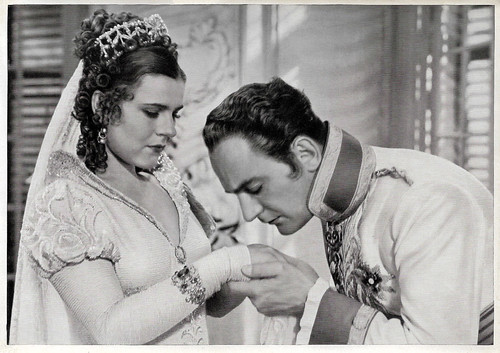
German collectors card in the series 'Vom Werden deutscher Filmkunst - Der Tonfilm', album no. 11, picture no. 51. Photo: Cine-Allianz / Ross Verlag. Paula Wessely and Willi Forst in So endete eine Liebe/End of an Affair (Karl Hartl, 1934).
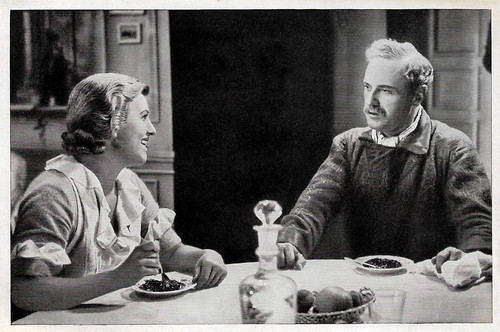
German collectors card in the series 'Vom Werden deutscher Filmkunst - Der Tonfilm', album no. 11, picture no. 53. Photo: Terra-Film / Ross Verlag. Maria Paudler and Harry Liedtke in Wenn am Sonntagabend die Dorfmusik spielt/When the Village Band Plays on a Sunday Evening (Charles Klein, 1933).
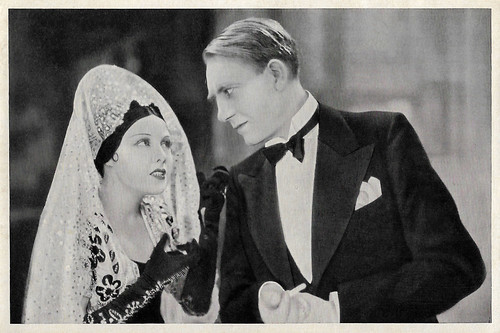
German collectors card in the series 'Vom Werden deutscher Filmkunst - Der Tonfilm', album no. 11, picture no. 55, group 44. Photo: Ondra-Lamac-Film / Ross Verlag. Anny Ondra and Mathias Wieman in Fraulein Hoffmanns Erzählungen/The Tales of Ms. Hoffmann (Karel Lamac, 1933).
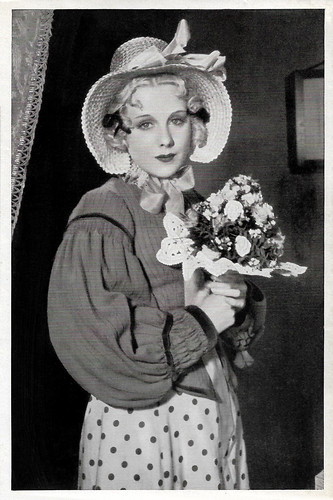
German collectors card in the series 'Vom Werden deutscher Filmkunst - Der Tonfilm', album no. 11, picture no. 56. Photo: Ondra-Lamac-Film / Ross Verlag. Anny Ondra in Klein Dorrit/Little Dorrit (Karel Lamac, 1934).
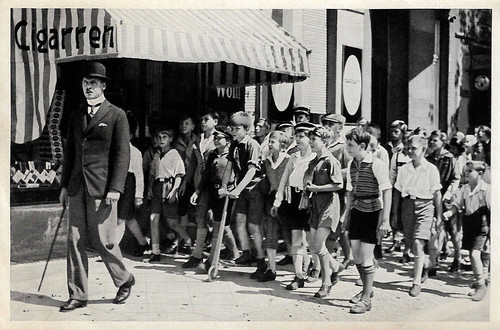
German collectors card in the series 'Vom Werden deutscher Filmkunst - Der Tonfilm', album no. 11, picture no. 58, group 44. Photo: Ufa / Ross Verlag. Fritz Rasp in Emil und die Detektive/Emil and the Detectives (Gerhard Lamprecht, 1931).
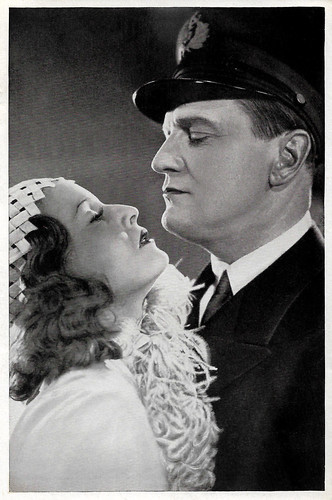
German collectors card in the series 'Vom Werden deutscher Filmkunst - Der Tonfilm', album no. 11, picture no. 61. Photo: Ufa / Ross Verlag. Lilian Harvey and Harry Liedtke in Nie wieder Liebe!/No More Love (Anatole Litvak, 1931).
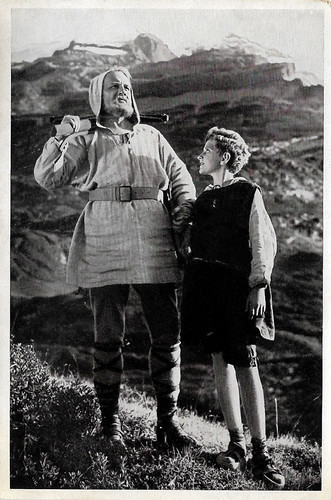
German collectors card in the series 'Vom Werden deutscher Filmkunst - Der Tonfilm', album no. 11, picture no. 64. Photo: Terra-Film / Ross Verlag. Hans Marr as Wilhelm Tell and Detlef Willecke as his son Walter in Wilhelm Tell/The Legend of William Tell (Heinz Paul, 1934).
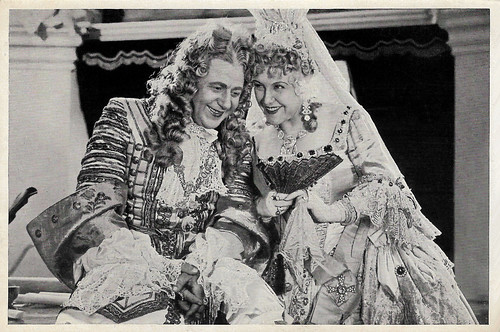
German collectors card in the series 'Vom Werden deutscher Filmkunst - Der Tonfilm', album no. 11, picture no. 68, group 44. Photo: Ufa / Ross Verlag. Paul Hörbiger and Ida Wüst in Des jungen Dessauers grosse Liebe/The young Dessauer's great love (Arthur Robison, 1933).
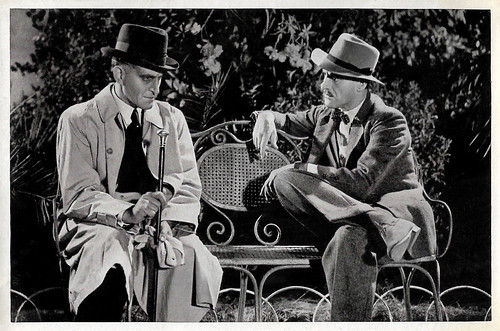
German collectors card in the series 'Vom Werden deutscher Filmkunst - Der Tonfilm', album no. 11, picture no. 69. Photo: Ufa / Ross Verlag. Albrecht Schoenhals in a double role in Fürst Woronzeff/Prince Woronzeff (Arthur Robison, 1934).
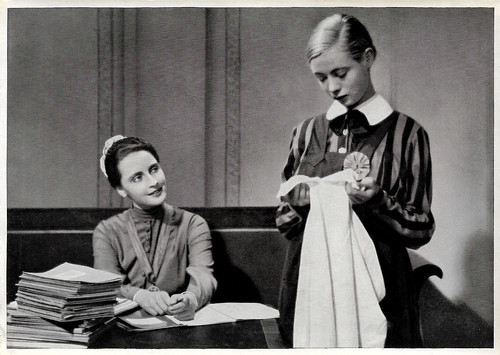
German collectors card in the series 'Vom Werden deutscher Filmkunst - Der Tonfilm', album no. 11, picture no. 71. Photo: Froelich-Film / Ross Verlag. Dorothea Wieck and Hertha Thiele in Mädchen in Uniform/Girls in Uniform (Leontine Sagan, 1931).
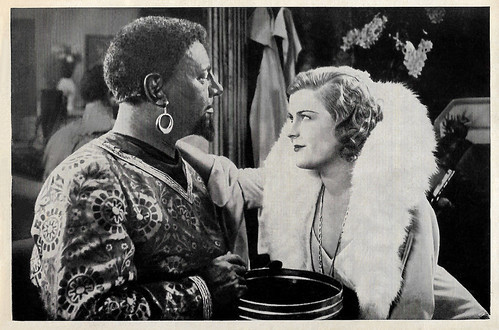
German collectors card in the series 'Vom Werden deutscher Filmkunst - Der Tonfilm', album no. 11, picture no. 72, group 44. Photo: Ufa / Ross Verlag. Emil Jannings and Renate Müller in Liebling der Götter/Darling of the Gods (Hanns Schwarz, 1930).
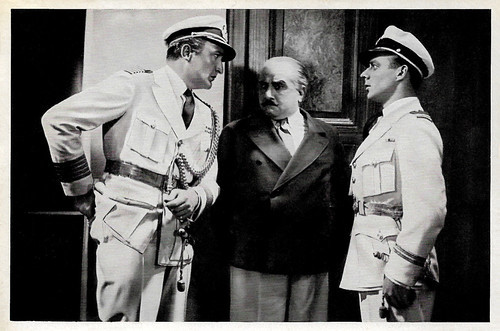
German collectors card in the series 'Vom Werden deutscher Filmkunst - Der Tonfilm', album no. 11, picture no. 73. Photo: Ufa / Ross Verlag. Hans Albers, Karl Ettlinger and Heinz Rühmann in Bomben auf Monte Carlo/Bombs Over Monte Carlo (Hanns Schwarz, 1931).
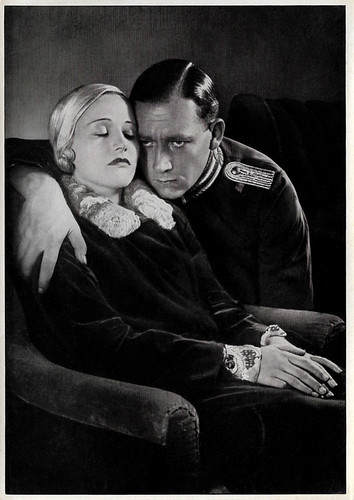
German collectors card in the series 'Vom Werden deutscher Filmkunst - Der Tonfilm', album no. 11, picture no. 75. Photo: Ufa / Ross Verlag. Lien Deyers and Mathias Wieman in Rosenmontag/Love's Carnival (Hans Steinhoff, 1930).
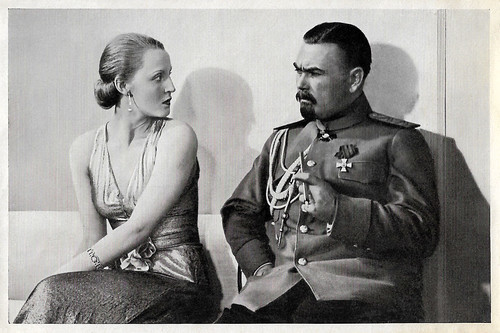
German collectors card in the series 'Vom Werden deutscher Filmkunst - Der Tonfilm', album no. 11, picture no. 79. Photo: Ufa / Ross Verlag. Brigitte Helm and Oskar Homolka in Im Geheimdienst/In the Employ of the Secret Service (Gustav Ucicky, 1931).
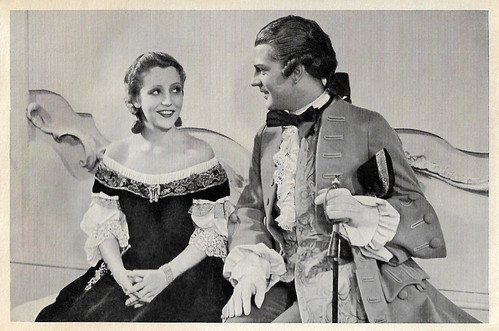
German collectors card in the series 'Vom Werden deutscher Filmkunst - Der Tonfilm', album no. 11, picture no. 81, group 44. Photo: Ufa / Ross Verlag. Käthe von Nagy and Viktor de Kowa in Der junge Baron Neuhaus/Night in May (Gustav Ucicky, 1934).
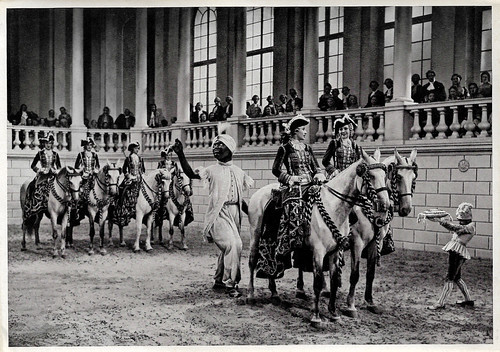
German collectors card in the series 'Vom Werden deutscher Filmkunst - Der Tonfilm', album no. 11, picture no. 82. Photo: Ufa / Ross Verlag. Lola Chlud and Käthe von Nagy in Der junge Baron Neuhaus/Night in May (Gustav Ucicky, 1934).
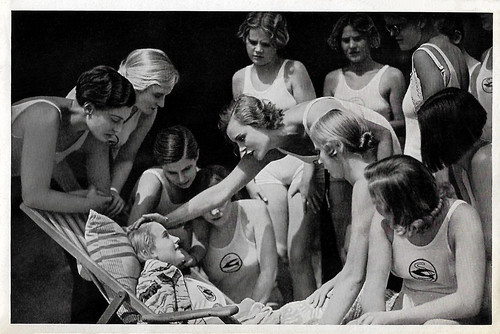
German collectors card in the series 'Vom Werden deutscher Filmkunst - Der Tonfilm', album no. 11, picture no. 83. Photo: Fanal-Terra-Produktion / Ross Verlag. Karin Hardt in Acht Mädels im Boot/Eight Girls in a Boat (Erich Waschneck, 1932).
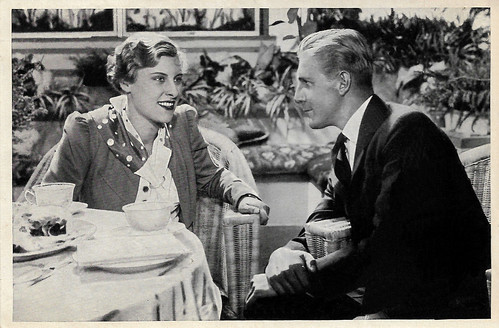
German collectors card in the series 'Vom Werden deutscher Filmkunst - Der Tonfilm', album no. 11, picture no. 85, group 44. Photo: Ufa / Ross Verlag. Marianne Hoppe and Hans Schlenck in Heideschulmeister Uwe Karsten/The Country Schoolmaster (Carl Heinz Wolff, 1933).
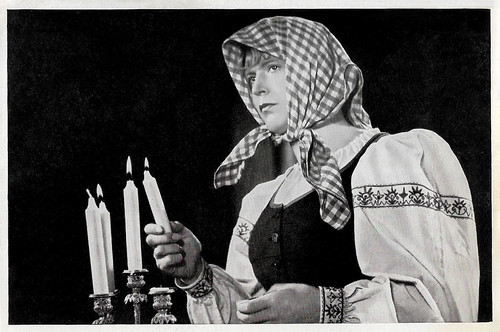
German collectors card in the series 'Vom Werden deutscher Filmkunst - Der Tonfilm', album no. 11, image no. 87. Photo: Itala-Film / Ross Verlag. Gustav Fröhlich in Abenteuer eines jungen Herrn in Polen/Love and Alarum (Gustav Fröhlich, 1934).
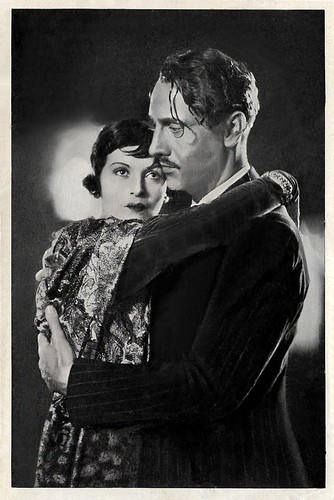
German collectors card in the series 'Vom Werden deutscher Filmkunst - Der Tonfilm', album no. 11, picture no. 89. Photo: Ariel-Film / Ross Verlag. Sybille Schmitz and Siegfried Schürenberg in Der Herr der Welt/Master of the World (Harry Piel, 1934).
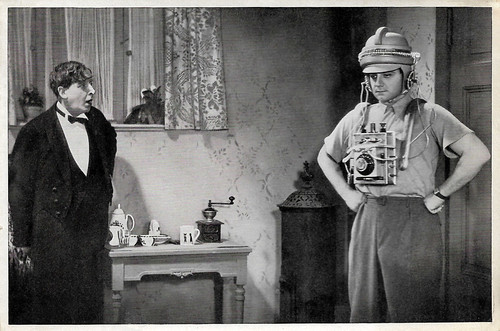
German collectors card in the series 'Vom Werden deutscher Filmkunst - Der Tonfilm', album no. 11, picture no. 90. Photo: Ariel-Film / Ross Verlag. Fritz Odemar and Harry Piel in Ein Unsichtbarer geht durch die Stadt/An Invisible Man Goes Through the City (Harry Piel, 1934).
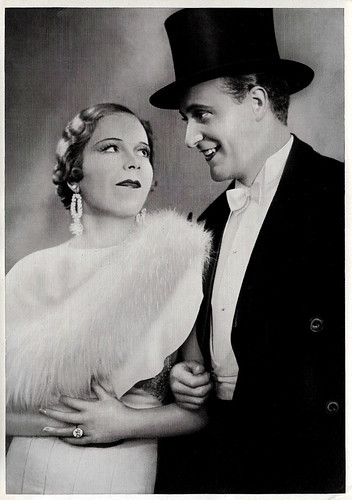
German collectors card in the series 'Vom Werden deutscher Filmkunst - Der Tonfilm', album no. 11, picture no. 92. Photo: Ufa / Ross Verlag. Renate Müller and Willy Fritsch in Saison in Kairo/Cairo Season (Reinhold Schünzel, 1933).
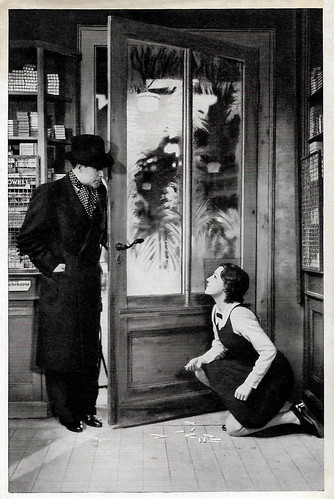
German collectors card in the series 'Vom Werden deutscher Filmkunst - Der Tonfilm', album no. 11, picture no. 94. Photo: Ufa / Ross Verlag. Willy Fritsch and Käthe von Nagy in Die Töchter ihrer Exzellenz/The daughters of her excellence (Reinhold Schünzel, 1934).
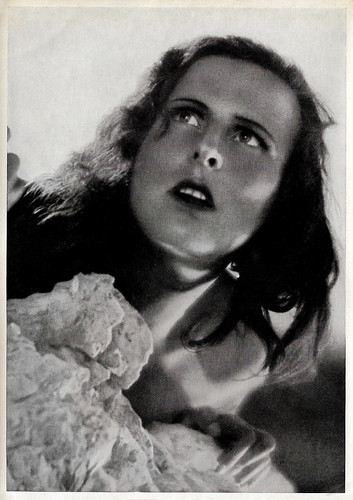
German collectors card in the series 'Vom Werden deutscher Filmkunst - Der Tonfilm', album no. 11, picture no. 98. Photo: Aafa / Ross Verlag. Leni Riefenstahl in Das blaue Licht/The blaue Light (Leni Riefenstahl, 1932).
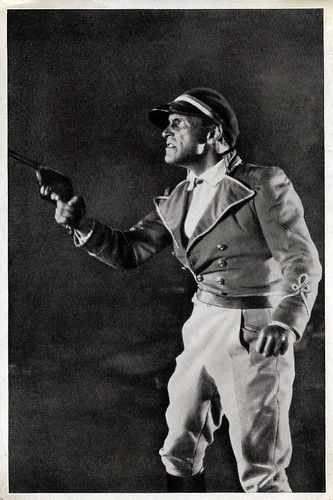
German collectors card in the series 'Vom Werden deutscher Filmkunst - Der Tonfilm', album no. 11, picture no. 99. Photo: Deutsche Universal-Film A.G. / Ross Verlag. Luis Trenker in Der Rebell/The Rebel (Curtis Bernhardt, Edwin H. Knopf, Luis Trenker, 1932).
To be continued.

German collectors card in the series 'Vom Werden deutscher Filmkunst - Der Tonfilm', album no. 11, picture no. 51. Photo: Cine-Allianz / Ross Verlag. Paula Wessely and Willi Forst in So endete eine Liebe/End of an Affair (Karl Hartl, 1934).

German collectors card in the series 'Vom Werden deutscher Filmkunst - Der Tonfilm', album no. 11, picture no. 53. Photo: Terra-Film / Ross Verlag. Maria Paudler and Harry Liedtke in Wenn am Sonntagabend die Dorfmusik spielt/When the Village Band Plays on a Sunday Evening (Charles Klein, 1933).

German collectors card in the series 'Vom Werden deutscher Filmkunst - Der Tonfilm', album no. 11, picture no. 55, group 44. Photo: Ondra-Lamac-Film / Ross Verlag. Anny Ondra and Mathias Wieman in Fraulein Hoffmanns Erzählungen/The Tales of Ms. Hoffmann (Karel Lamac, 1933).

German collectors card in the series 'Vom Werden deutscher Filmkunst - Der Tonfilm', album no. 11, picture no. 56. Photo: Ondra-Lamac-Film / Ross Verlag. Anny Ondra in Klein Dorrit/Little Dorrit (Karel Lamac, 1934).

German collectors card in the series 'Vom Werden deutscher Filmkunst - Der Tonfilm', album no. 11, picture no. 58, group 44. Photo: Ufa / Ross Verlag. Fritz Rasp in Emil und die Detektive/Emil and the Detectives (Gerhard Lamprecht, 1931).

German collectors card in the series 'Vom Werden deutscher Filmkunst - Der Tonfilm', album no. 11, picture no. 61. Photo: Ufa / Ross Verlag. Lilian Harvey and Harry Liedtke in Nie wieder Liebe!/No More Love (Anatole Litvak, 1931).

German collectors card in the series 'Vom Werden deutscher Filmkunst - Der Tonfilm', album no. 11, picture no. 64. Photo: Terra-Film / Ross Verlag. Hans Marr as Wilhelm Tell and Detlef Willecke as his son Walter in Wilhelm Tell/The Legend of William Tell (Heinz Paul, 1934).

German collectors card in the series 'Vom Werden deutscher Filmkunst - Der Tonfilm', album no. 11, picture no. 68, group 44. Photo: Ufa / Ross Verlag. Paul Hörbiger and Ida Wüst in Des jungen Dessauers grosse Liebe/The young Dessauer's great love (Arthur Robison, 1933).

German collectors card in the series 'Vom Werden deutscher Filmkunst - Der Tonfilm', album no. 11, picture no. 69. Photo: Ufa / Ross Verlag. Albrecht Schoenhals in a double role in Fürst Woronzeff/Prince Woronzeff (Arthur Robison, 1934).

German collectors card in the series 'Vom Werden deutscher Filmkunst - Der Tonfilm', album no. 11, picture no. 71. Photo: Froelich-Film / Ross Verlag. Dorothea Wieck and Hertha Thiele in Mädchen in Uniform/Girls in Uniform (Leontine Sagan, 1931).

German collectors card in the series 'Vom Werden deutscher Filmkunst - Der Tonfilm', album no. 11, picture no. 72, group 44. Photo: Ufa / Ross Verlag. Emil Jannings and Renate Müller in Liebling der Götter/Darling of the Gods (Hanns Schwarz, 1930).

German collectors card in the series 'Vom Werden deutscher Filmkunst - Der Tonfilm', album no. 11, picture no. 73. Photo: Ufa / Ross Verlag. Hans Albers, Karl Ettlinger and Heinz Rühmann in Bomben auf Monte Carlo/Bombs Over Monte Carlo (Hanns Schwarz, 1931).

German collectors card in the series 'Vom Werden deutscher Filmkunst - Der Tonfilm', album no. 11, picture no. 75. Photo: Ufa / Ross Verlag. Lien Deyers and Mathias Wieman in Rosenmontag/Love's Carnival (Hans Steinhoff, 1930).

German collectors card in the series 'Vom Werden deutscher Filmkunst - Der Tonfilm', album no. 11, picture no. 79. Photo: Ufa / Ross Verlag. Brigitte Helm and Oskar Homolka in Im Geheimdienst/In the Employ of the Secret Service (Gustav Ucicky, 1931).

German collectors card in the series 'Vom Werden deutscher Filmkunst - Der Tonfilm', album no. 11, picture no. 81, group 44. Photo: Ufa / Ross Verlag. Käthe von Nagy and Viktor de Kowa in Der junge Baron Neuhaus/Night in May (Gustav Ucicky, 1934).

German collectors card in the series 'Vom Werden deutscher Filmkunst - Der Tonfilm', album no. 11, picture no. 82. Photo: Ufa / Ross Verlag. Lola Chlud and Käthe von Nagy in Der junge Baron Neuhaus/Night in May (Gustav Ucicky, 1934).

German collectors card in the series 'Vom Werden deutscher Filmkunst - Der Tonfilm', album no. 11, picture no. 83. Photo: Fanal-Terra-Produktion / Ross Verlag. Karin Hardt in Acht Mädels im Boot/Eight Girls in a Boat (Erich Waschneck, 1932).

German collectors card in the series 'Vom Werden deutscher Filmkunst - Der Tonfilm', album no. 11, picture no. 85, group 44. Photo: Ufa / Ross Verlag. Marianne Hoppe and Hans Schlenck in Heideschulmeister Uwe Karsten/The Country Schoolmaster (Carl Heinz Wolff, 1933).

German collectors card in the series 'Vom Werden deutscher Filmkunst - Der Tonfilm', album no. 11, image no. 87. Photo: Itala-Film / Ross Verlag. Gustav Fröhlich in Abenteuer eines jungen Herrn in Polen/Love and Alarum (Gustav Fröhlich, 1934).

German collectors card in the series 'Vom Werden deutscher Filmkunst - Der Tonfilm', album no. 11, picture no. 89. Photo: Ariel-Film / Ross Verlag. Sybille Schmitz and Siegfried Schürenberg in Der Herr der Welt/Master of the World (Harry Piel, 1934).

German collectors card in the series 'Vom Werden deutscher Filmkunst - Der Tonfilm', album no. 11, picture no. 90. Photo: Ariel-Film / Ross Verlag. Fritz Odemar and Harry Piel in Ein Unsichtbarer geht durch die Stadt/An Invisible Man Goes Through the City (Harry Piel, 1934).

German collectors card in the series 'Vom Werden deutscher Filmkunst - Der Tonfilm', album no. 11, picture no. 92. Photo: Ufa / Ross Verlag. Renate Müller and Willy Fritsch in Saison in Kairo/Cairo Season (Reinhold Schünzel, 1933).

German collectors card in the series 'Vom Werden deutscher Filmkunst - Der Tonfilm', album no. 11, picture no. 94. Photo: Ufa / Ross Verlag. Willy Fritsch and Käthe von Nagy in Die Töchter ihrer Exzellenz/The daughters of her excellence (Reinhold Schünzel, 1934).

German collectors card in the series 'Vom Werden deutscher Filmkunst - Der Tonfilm', album no. 11, picture no. 98. Photo: Aafa / Ross Verlag. Leni Riefenstahl in Das blaue Licht/The blaue Light (Leni Riefenstahl, 1932).

German collectors card in the series 'Vom Werden deutscher Filmkunst - Der Tonfilm', album no. 11, picture no. 99. Photo: Deutsche Universal-Film A.G. / Ross Verlag. Luis Trenker in Der Rebell/The Rebel (Curtis Bernhardt, Edwin H. Knopf, Luis Trenker, 1932).
To be continued.
Published on March 21, 2020 23:00
March 20, 2020
Guest post: Let the sun shine in!
Yes, we have a guest post at EFSP. Today the floor is for my friend, collector Carla Bosch a.k.a. Meiter.
Carla: "Some time ago I told Paul I found some lovely cards in my magic attic. I was looking for other cards which I know must be there too, but instead, I found these. This often happens: when you search for one thing you will find another thing that has been lost a long time ago too. The cards I found were vintage black and white cards with filmstars wearing bathing suits. Paul immediately suggested I should make a list as the spring approaches and we are longing for some sun. I thought it would be a nice idea to pick some cards that are not on European Film Star Postcards, but this proved to be rather difficult. It is hard to find a card that is not on this site. However, I did find five cards that should have been on the EFSP site… I added a few cards of American filmstars. The site is moving towards a more worldwide approach and coverage, so this should not be a problem."
1. Martine Carol
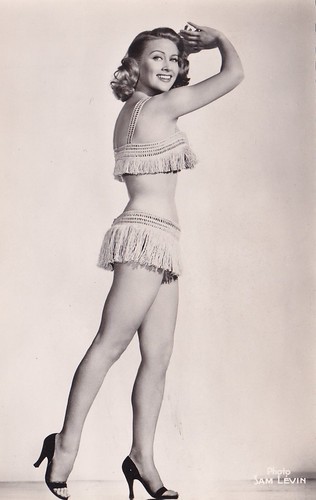
Vintage postcard. Photo: Sam Lévin. Collection: Carla Bosch.
Carla: "French actress Martine Carol in a bikini with frills. I don’t think the bikini was meant to swim with. Many considered her a French Marilyn Monroe . I do not agree. Perhaps her personal problems: alcohol, drugs, a suicide attempt, and four marriages remind of Marilyn’s stormy life, but her appearance in swimwear cannot be compared with Marilyn."
2. Maria Alberghetti
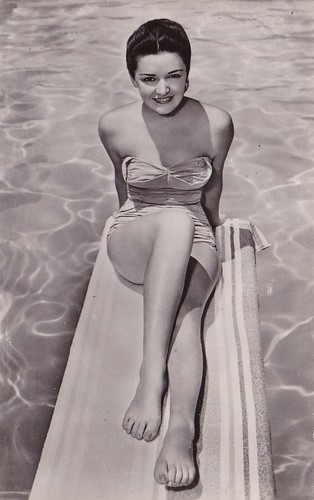
French postcard by Editions P.I., Paris, no. S 173. Collection: Carla Bosch.
"A lovely card of Italian-American operatic singer and actress (Anna) Maria Alberghetti. She was compared to another Italian-born actress: Pier Angeli . Alberghetti, however, had a rather more successful career and personal life. I think she radiates this satisfaction with her life on this card. After the photoshoot, she rolls off her air mattress and goes for a swim."
3. Beatrice Altariba
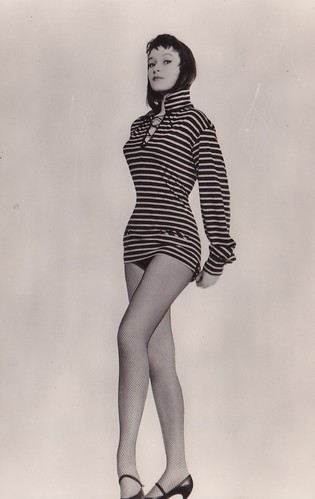
Vintage postcard. Collection: Carla Bosch.
"French actress Beatrice Altariba . Frankly, I don’t know what to make of her beachwear. I suppose she wears a bathing suit or bikini beneath her long-sleeved sweater. Her hair is tucked in the collar and she wears shoes with high heels. Our (or, at least mine) attention is drawn to her legs. And yes, she has nice legs. (I read she was a model as well.) I think it is a wonderful card and perhaps that is all there is to it."
4. Brigitte Auber
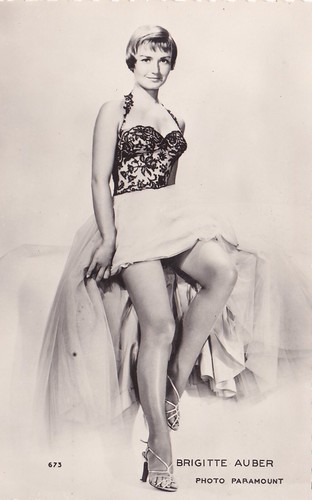
Vintage postcard. Photo: Paramount. Collection: Carla Bosch.
"French actress Brigitte Auber . I am not sure whether it is a bathing suit Brigitte wears. It could be a dress and she pulls up the skirt. Or: she wears a bathing suit and has a large tablecloth across her legs. Anyway, Brigitte does show us her legs. On purpose."
5. Claudine Cereda
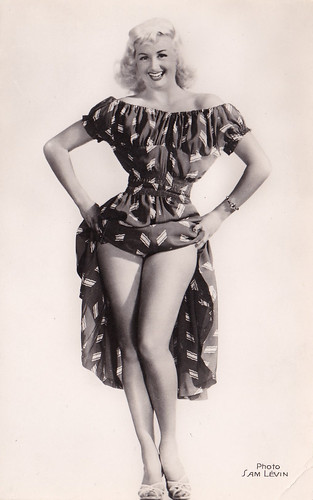
French postcard. Photo: Sam Lévin. Collection: Carla Bosch.
"On the card, it says this is “Cereda”. I searched the internet and have come to the conclusion this must be Claudine Cereda, a French singer and dancer. I don’t know anything about her. She does not wear a bathing suit in this picture. Instead, she wears a summer dress and shows us her legs. Just like Brigitte Auber. She radiates a kind of cheerfulness and it looks as if she is preparing to dance the can-can."
6. Colleen Miller
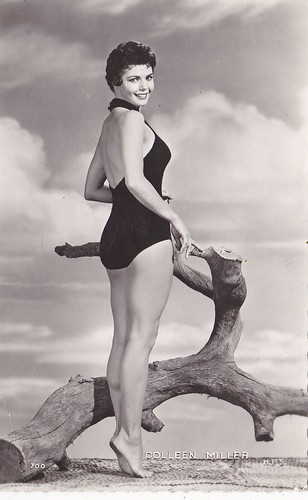
French postcard by P.I., Paris, no. 700. Photo: H.P.S. Collection: Carla Bosch.
"American actress Colleen Miller. On this card, Colleen wears a decent and practical bathing suit. I think she is standing in a studio with a tree trunk. Because of this bathing suit, I have the impression that Colleen is a nice, decent and practical girl as well. Of course, I could be wrong and she is a wild and unpredictable girl. This card, however, tells us something different."
7. Mitzi Gaynor
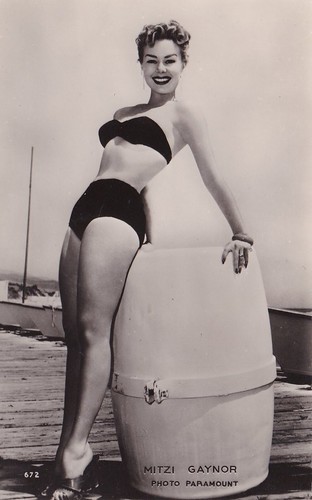
French postcard by Editions P.I., Paris, no. 672. Photo: Paramount. Collection: Carla Bosch.
"American actress Mitzi Gaynor. Mitzi is wearing a bikini. She apparently is standing on a scaffolding, because we can see a boat behind her. But of course, we can never be sure. She is an actress, acting in movies in studios, and she can be standing in a studio for all we know. Yet, I like to think she is standing in the cold in her bikini on a scaffolding."
8. Ann Miller
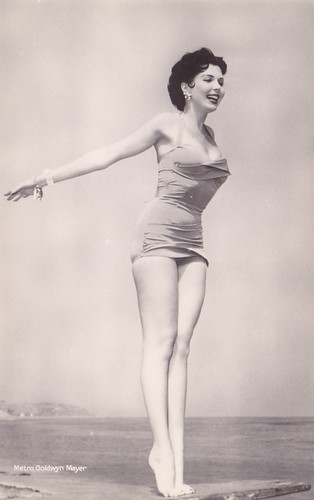
Vintage postcard. Photo: Metro Goldwyn Mayer. Collection: Carla Bosch.
"American dancer, singer and actress Ann Miller wearing a bathing suit. This picture radiates a kind of 'lust for life'. Ann stands on her toes, arms back, in a posture as if she is going to dive into the water. She doesn’t mind the camera. Yet, she knew she was going to be photographed because she did not take off her jewelry. I doubt whether she would wear bracelets and earrings if she was planning to take a swim. Again in a studio?"
9. Jayne Mansfield
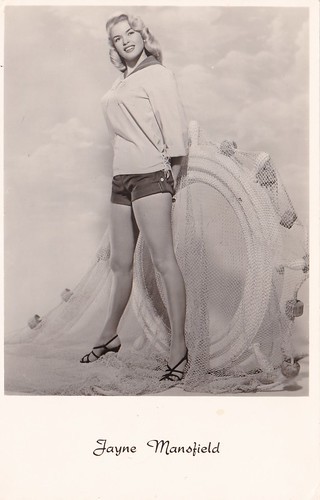
Vintage postcard. Collection: Carla Bosch.
"I like this card of American actress and pin-up Jayne Mansfield because it is rather different from what we are used to from Jayne. My guess is that this picture was taken when she was not yet world-famous. She is wearing a nice pair of shorts, a sweater with long sleeves and sandals which are partly hidden by fishing nets. My attention is drawn to her pretty face and her bare legs. On pictures that were published later (again: it is an assumption this is an early picture) my attention is usually drawn to her obvious bombshell appearance. On this card, Jayne is not a sex bomb yet."
10. Marilyn Monroe
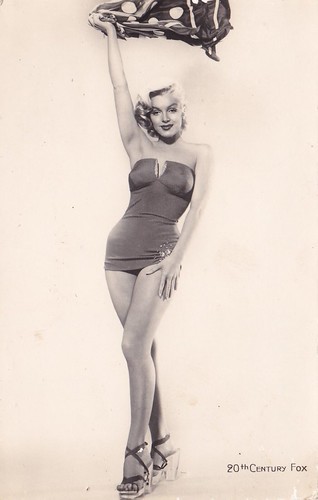
French postcard by Editions du Globe, no. 507. Photo: 20th Century Fox. Collection: Carla Bosch.
"And of course, no list of mine is complete without Marilyn Monroe . As I said before, I do not have many vintage cards of Marilyn, but I cannot stop bragging about the few I do have. This is one of them. My English Marilyn-loving-friend gave it to me as a present a week ago. So I can immediately boast about it on this list and tell how much I love this card. Again Marilyn is an outstanding example of a nice and decent pin-up postcard. She is wearing a strapless bathing suit and is on the verge of throwing her towel away. I know it probably is not a towel, but every card must have a story. So a towel it is.
These were 10 bathing suit cards that will prepare us for the approaching spring. I am always struck by how nice these cards are. They are in no way vulgar or cheap. They all radiate a kind of optimism and happiness which seems to belong to these years, I think. They were meant to be 'pinned-up' on a wall. (Hence the term 'pin-up'.) I often think they could have been used for advertising bathing suits. Fun fact: female pin-ups were called 'cheesecake' in America. Male pin-ups were called 'beefcake'.
I was looking for a bunch of large 'Ross' photos when instead I found these cards. I am curious about what I will find next time I search for those 'Ross' photos."
Carla, thank you very much for this sunny post. For me, spring has arrived!
Carla: "Some time ago I told Paul I found some lovely cards in my magic attic. I was looking for other cards which I know must be there too, but instead, I found these. This often happens: when you search for one thing you will find another thing that has been lost a long time ago too. The cards I found were vintage black and white cards with filmstars wearing bathing suits. Paul immediately suggested I should make a list as the spring approaches and we are longing for some sun. I thought it would be a nice idea to pick some cards that are not on European Film Star Postcards, but this proved to be rather difficult. It is hard to find a card that is not on this site. However, I did find five cards that should have been on the EFSP site… I added a few cards of American filmstars. The site is moving towards a more worldwide approach and coverage, so this should not be a problem."
1. Martine Carol

Vintage postcard. Photo: Sam Lévin. Collection: Carla Bosch.
Carla: "French actress Martine Carol in a bikini with frills. I don’t think the bikini was meant to swim with. Many considered her a French Marilyn Monroe . I do not agree. Perhaps her personal problems: alcohol, drugs, a suicide attempt, and four marriages remind of Marilyn’s stormy life, but her appearance in swimwear cannot be compared with Marilyn."
2. Maria Alberghetti

French postcard by Editions P.I., Paris, no. S 173. Collection: Carla Bosch.
"A lovely card of Italian-American operatic singer and actress (Anna) Maria Alberghetti. She was compared to another Italian-born actress: Pier Angeli . Alberghetti, however, had a rather more successful career and personal life. I think she radiates this satisfaction with her life on this card. After the photoshoot, she rolls off her air mattress and goes for a swim."
3. Beatrice Altariba

Vintage postcard. Collection: Carla Bosch.
"French actress Beatrice Altariba . Frankly, I don’t know what to make of her beachwear. I suppose she wears a bathing suit or bikini beneath her long-sleeved sweater. Her hair is tucked in the collar and she wears shoes with high heels. Our (or, at least mine) attention is drawn to her legs. And yes, she has nice legs. (I read she was a model as well.) I think it is a wonderful card and perhaps that is all there is to it."
4. Brigitte Auber

Vintage postcard. Photo: Paramount. Collection: Carla Bosch.
"French actress Brigitte Auber . I am not sure whether it is a bathing suit Brigitte wears. It could be a dress and she pulls up the skirt. Or: she wears a bathing suit and has a large tablecloth across her legs. Anyway, Brigitte does show us her legs. On purpose."
5. Claudine Cereda

French postcard. Photo: Sam Lévin. Collection: Carla Bosch.
"On the card, it says this is “Cereda”. I searched the internet and have come to the conclusion this must be Claudine Cereda, a French singer and dancer. I don’t know anything about her. She does not wear a bathing suit in this picture. Instead, she wears a summer dress and shows us her legs. Just like Brigitte Auber. She radiates a kind of cheerfulness and it looks as if she is preparing to dance the can-can."
6. Colleen Miller

French postcard by P.I., Paris, no. 700. Photo: H.P.S. Collection: Carla Bosch.
"American actress Colleen Miller. On this card, Colleen wears a decent and practical bathing suit. I think she is standing in a studio with a tree trunk. Because of this bathing suit, I have the impression that Colleen is a nice, decent and practical girl as well. Of course, I could be wrong and she is a wild and unpredictable girl. This card, however, tells us something different."
7. Mitzi Gaynor

French postcard by Editions P.I., Paris, no. 672. Photo: Paramount. Collection: Carla Bosch.
"American actress Mitzi Gaynor. Mitzi is wearing a bikini. She apparently is standing on a scaffolding, because we can see a boat behind her. But of course, we can never be sure. She is an actress, acting in movies in studios, and she can be standing in a studio for all we know. Yet, I like to think she is standing in the cold in her bikini on a scaffolding."
8. Ann Miller

Vintage postcard. Photo: Metro Goldwyn Mayer. Collection: Carla Bosch.
"American dancer, singer and actress Ann Miller wearing a bathing suit. This picture radiates a kind of 'lust for life'. Ann stands on her toes, arms back, in a posture as if she is going to dive into the water. She doesn’t mind the camera. Yet, she knew she was going to be photographed because she did not take off her jewelry. I doubt whether she would wear bracelets and earrings if she was planning to take a swim. Again in a studio?"
9. Jayne Mansfield

Vintage postcard. Collection: Carla Bosch.
"I like this card of American actress and pin-up Jayne Mansfield because it is rather different from what we are used to from Jayne. My guess is that this picture was taken when she was not yet world-famous. She is wearing a nice pair of shorts, a sweater with long sleeves and sandals which are partly hidden by fishing nets. My attention is drawn to her pretty face and her bare legs. On pictures that were published later (again: it is an assumption this is an early picture) my attention is usually drawn to her obvious bombshell appearance. On this card, Jayne is not a sex bomb yet."
10. Marilyn Monroe

French postcard by Editions du Globe, no. 507. Photo: 20th Century Fox. Collection: Carla Bosch.
"And of course, no list of mine is complete without Marilyn Monroe . As I said before, I do not have many vintage cards of Marilyn, but I cannot stop bragging about the few I do have. This is one of them. My English Marilyn-loving-friend gave it to me as a present a week ago. So I can immediately boast about it on this list and tell how much I love this card. Again Marilyn is an outstanding example of a nice and decent pin-up postcard. She is wearing a strapless bathing suit and is on the verge of throwing her towel away. I know it probably is not a towel, but every card must have a story. So a towel it is.
These were 10 bathing suit cards that will prepare us for the approaching spring. I am always struck by how nice these cards are. They are in no way vulgar or cheap. They all radiate a kind of optimism and happiness which seems to belong to these years, I think. They were meant to be 'pinned-up' on a wall. (Hence the term 'pin-up'.) I often think they could have been used for advertising bathing suits. Fun fact: female pin-ups were called 'cheesecake' in America. Male pin-ups were called 'beefcake'.
I was looking for a bunch of large 'Ross' photos when instead I found these cards. I am curious about what I will find next time I search for those 'Ross' photos."
Carla, thank you very much for this sunny post. For me, spring has arrived!
Published on March 20, 2020 23:00
March 19, 2020
Al Pacino
During the 1970s, American actor Al Pacino (1940) established himself with such films as The Godfather (1972), Serpico (1973), The Godfather: Part II (1974) and Dog Day Afternoon (1975). In the following decades, he became an enduring icon of the American cinema. He won the Triple Crown of Acting: an Oscar for Best Actor for Scent of a Woman (1992); a Tony for Best Supporting Actor in the play 'Does a Tiger Wear a Necktie?' (1969) and for Best Actor in the play 'The Basic Training of Pavlo Hummel' (1977); and an Emmy for Best Actor in the Miniseries Angels in America (2003).
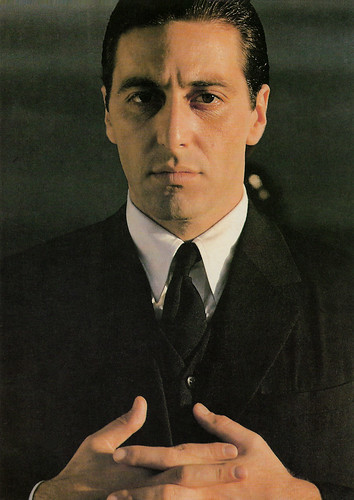
British postcard by Star-Graphics, no. S 89. Photo: Al Pacino in The Godfather (Francis Ford Coppola, 1972).
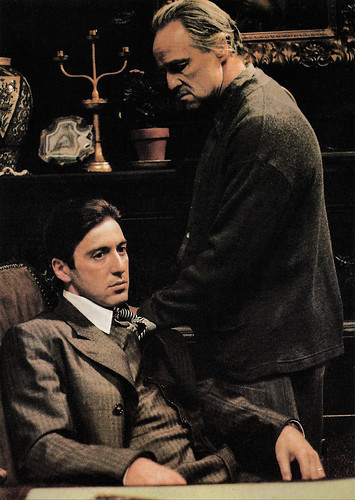
British postcard by Star-Graphics, no. S 91. Photo: Al Pacino and Marlon Brando in The Godfather (Francis Ford Coppola, 1972).
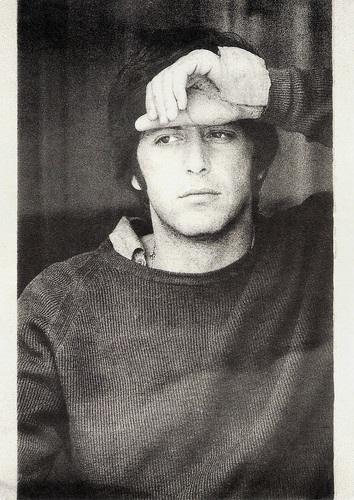
French postcard in the Collection In Cinéma by Editions La Malibran, Paris / Nancy, 1989, no. CA 51. Photo: Al Pacino in Scarecrow (Jerry Schatzberg, 1973).
Michael Corleone
Alfredo James 'Al' Pacino was born in 1940 in Manhattan, New York City, to Italian-American parents, Rose (nee Gerardi) and Sal Pacino, who worked as an insurance agent. His maternal grandfather was born in Corleone, Sicily. His parents divorced when he was two years old.
His mother moved them into his grandparents' home in the South Bronx. In his teenage years, Pacino was known as 'Sonny' to his friends. Pacino found himself often repeating the plots and voices of characters he had seen in films. Bored and unmotivated in school, he found a haven in school plays, and his interest soon blossomed into a full-time career.
He attended the High School of the Performing Arts until he dropped out at age 17. In 1962, Pacino's mother died at the age of 43. The following year, his grandfather James also died. Starting on stage, he went through a period of depression and poverty, sometimes having to borrow bus fare to succeed to auditions. He made it into the prestigious Actors Studio in 1966, studying under Lee Strasberg, creator of the Method Approach that would become the trademark of many 1970s-era actors.
After appearing in a string of plays in supporting roles, Pacino finally attained success off-Broadway with Israel Horovitz's 'The Indian Wants the Bronx', winning an Obie Award for the 1966-1967 season. He was also nominated for a Best Actor Obie for 'Why Is a Crooked Letter' (1966). That was followed by a Tony Award for 'Does the Tiger Wear a Necktie?'
Pacino was a longtime member of David Wheeler's Theatre Company of Boston, for which he performed in 'Richard III' in Boston (1972-1973) and at the Cort Theater in New York City (1979). He also appeared in their productions of Bertolt Brecht's 'Arturo Ui' at the Charles Theater in Boston in 1975 and later in New York and London, and in David Rabe's 'The Basic Training of Pavlo Hummel' at the Longacre Theater in New York in 1977.
At the age of 29 he made his film debut with a supporting part in Me, Natalie (Fred Coe, 1969) featuring Patty Duke. In 1970, Pacino signed with the talent agency Creative Management Associates (CMA). He gained favourable notice for his first lead role as a heroin addict in The Panic in Needle Park (Jerry Schatzberg, 1971). These first feature films made a little departure from the gritty realistic stage performances that earned him respect.
Then came the role of Michael Corleone in The Godfather (Francis Ford Coppola, 1972). It was one of the most sought-after of the time: Robert Redford, Warren Beatty, Jack Nicholson , Ryan O'Neal, Robert De Niro and a host of other actors either wanted it or were mentioned. Pacino was rejected repeatedly by studio heads for the role, but Francis Ford Coppola fought for him. Coppola was successful but Pacino was reportedly in constant fear of being fired during the very difficult shoot. Ironically, The Godfather (1972) was a monster hit that earned Pacino his first Academy Award nomination for Best Supporting Actor. It turned out to be the breakthrough for both Pacino and director Francis Ford Coppola.
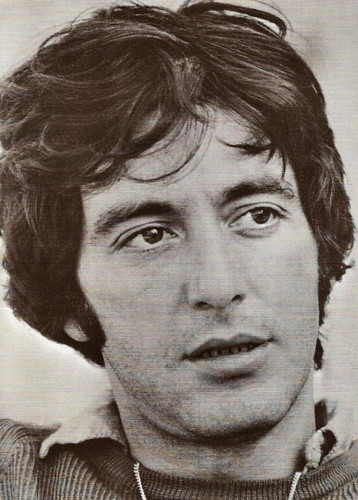
French postcard by Travelling Editions, Paris, no. CP7. Photo: Al Pacino in Scarecrow (Jerry Schatzberg, 1973).
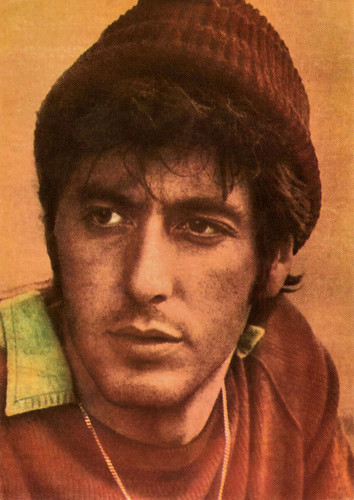
Romanian postcard by Casa Filmului Acin. Photo: Al Pacino in Scarecrow (Jerry Schatzberg, 1973).
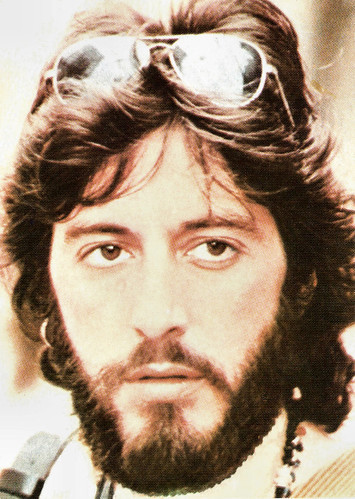
Romanian postcard by Casa Filmului Acin. Photo: Al Pacino in Serpico (Sidney Lumet, 1973).
Three consecutive Oscar nominations
Instead of taking on easier projects for the big money after this success, Al Pacino threw his support behind what he considered tough but important films. In 1973, Pacino co-starred in Scarecrow (Jerry Schatzberg, 1973), with Gene Hackman, and won the Palme d'Or at the Cannes Film Festival.
He also starred in the true-life crime drama Serpico (Sidney Lumet, 1973) and the tragic real-life bank robbery film Dog Day Afternoon (Sidney Lumet, 1975). In between, he returned as Michael Corleone in The Godfather: Part II (Francis Ford Coppola, 1974), the first sequel ever to win the Best Picture Oscar. For these three films, Pacino was nominated three consecutive years for the Best Actor Academy Award.
In 1977, he won his second Tony Award as Best Actor (Play) for 'The Basic Training of Pavlo Hummel' (1977). He faltered slightly with Bobby Deerfield (Sydney Pollack, 1977), but regained his stride with ...and justice for all. (Norman Jewison, 1979), for which he received another Academy Award nomination for Best Actor.
Unfortunately, this would signal the beginning of a decline in his career, which produced flops like the controversial Cruising (William Friedkin, 1980), and the comedy-drama Author! Author! (Arthur Hiller, 1982), with Dyan Cannon and Tuesday Weld.
Pacino cemented his legendary status with his role as Cuban drug lord Tony Montana in the ultra-violent cult film Scarface (Brian De Palma, 1983), with Michelle Pfeiffer and Steven Bauer. Keith Phipps at AllMovie : "Infinitely quotable and more than a little cartoonish, Brian De Palma's update of Howard Hawks' seminal gangster film revels in its freedom to be larger than life. A work as akin to pop art as any other form, it reworks the crime melodrama in bold, primary colors, mostly blood red. Attracting a great deal of attention for its violence at the time of its release, the controversy overshadowed the fact that everything in the film ran to extremes, including Pacino's performance, the director's visual style (which found him almost reverting to The Fury mode), the dialogue (from a script co-written by Oliver Stone), and most importantly the themes. "
Pedro Borges at IMDb : "a monumental mistake was about to follow. Revolution (Hugh Hudson, 1985) endured an endless and seemingly cursed shoot in which equipment was destroyed, the weather was terrible, and Pacino fell ill with pneumonia. Constant changes in the script further derailed the project. The Revolutionary War-themed film, considered among the worst films ever made, resulted in awful reviews and kept him off the screen for the next four years."
Returning to the stage, Pacino did much to give back and contribute to the theatre, which he considers his first love. He directed a film, The Local Stigmatic (1990), but it remains unreleased. He lifted his self-imposed exile playing a hard-drinking policeman in the striking Sea of Love (Harold Becker, 1989), with Ellen Barkin. This marked the second phase of Pacino's career, being the first to feature his now famous dark, owl eyes, and hoarse, gravelly voice.
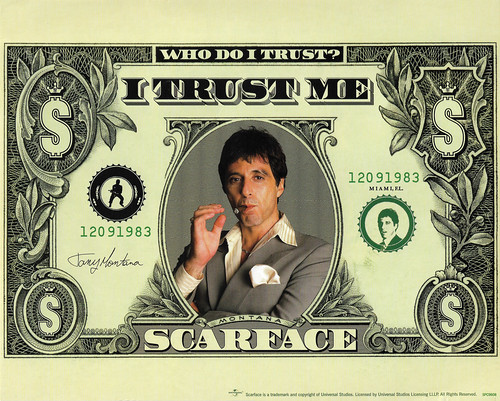
Big postcard by Pyramid Posters, Leicester, no. SPC9608. Photo: Universal Studios. Al Pacino in Scarface (Brian De Palma, 1983).
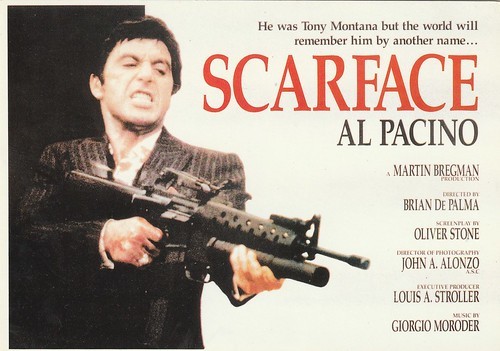
Postcard, no. C120. Photo: poster for Scarface (Brian De Palma, 1983). Collection: Daniël van der Aa.
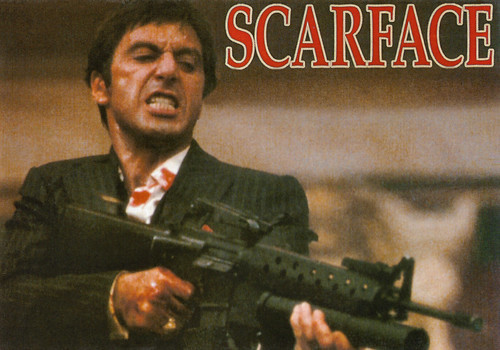
French postcard. Photo: Universal Studios. Al Pacino in Scarface (Brian De Palma, 1983).
Playing Satan
Returning to the Corleones, Al Pacino made The Godfather: Part III (Francis Ford Coppola, 1990) and earned raves for his first comedic role in the colourful adaptation Dick Tracy (Warren Beatty, 1990). This earned him another Academy Award nomination for Best Supporting Actor, and two years later he was nominated for Glengarry Glen Ross (James Foley, 1992).
He went into romantic mode for Frankie and Johnny (Garry Marshall, 1991) with Michelle Pfeiffer . In 1992, he finally won the Academy Award for Best Actor for his amazing performance as the blind U.S. Army Lieutenant Colonel Frank Slade in Scent of a Woman (Martin Brest, 1992). A mixture of technical perfection and charisma, the role was tailor-made for him and remains a classic.
The next few years would see Pacino becoming more comfortable with acting and films as a business, turning out great roles in great films with more frequency and less of the demanding personal involvement of his wilder days. Carlito's Way (Brian De Palma, 1993) with Sean Penn proved another gangster classic, as did the epic crime drama Heat (Michael Mann, 1995) co-starring Robert De Niro .
He directed the theatrical docudrama Looking for Richard (1996), a performance of selected scenes of William Shakespeare's 'Richard III' and a broader examination of Shakespeare's continuing role and relevance in popular culture. In Donnie Brasco (Mike Newell, 1997), Pacino played gangster 'Lefty' in the true story of undercover FBI agent Donnie Brasco ( Johnny Depp ) and his work in bringing down the Mafia from the inside.
Pacino played Satan in the supernatural thriller The Devil's Advocate (Taylor Hackford, 1997) which co-starred Keanu Reeves . The film was a success at the box office, taking US$150 million worldwide. He also gave commanding performances in The Insider (Michael Mann, 1999) with Russell Crowe, and Any Given Sunday (Oliver Stone, 1999) opposite Cameron Diaz .
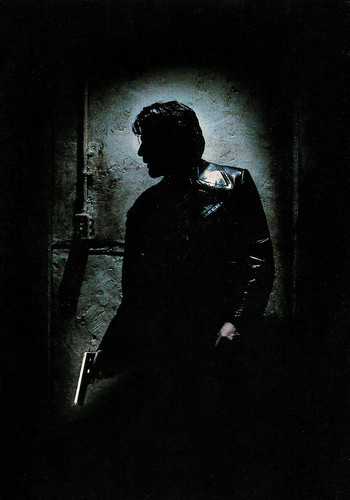
Dutch postcard by Boomerang, Amsterdam. Photo: Al Pacino in Carlito's Way (Brian De Palma, 1993).
Once Upon a Time in Hollywood
Al Pacino co-starred with Hillary Swank and Robin Williams in the mystery thriller Insomnia (Christopher Nolan, 2002), a remake of the Norwegian film of the same name. Pacino starred as Shylock in Michael Radford's film adaptation of The Merchant of Venice (2004), choosing to bring compassion and depth to a character traditionally played as a villainous caricature.
In the 2000s, he starred in a number of theatrical blockbusters, including Ocean's Thirteen (Steven Soderbergh, 2007) with George Clooney and Brad Pitt , but his choice in television roles like the vicious, closeted Roy Cohn in the HBO miniseries Angels in America (Tony Kushner, 2003) and his sensitive portrayal of Jack Kevorkian, in the television film You Don't Know Jack (Barry Levinson, 2010), are reminiscent of the bolder choices of his early career. Each television project garnered him an Emmy Award for Outstanding Lead Actor in a Miniseries or a Movie.
Recently, Pacino starred alongside Brad Pitt and Leonardo DiCaprio in Quentin Tarantino's comedy-drama Once Upon a Time in Hollywood (2019) and he co-starred with Robert De Niro in Martin Scorsese's Netflix film The Irishman (2019). He will play Meyer Offerman, a fictional Nazi hunter, in the Amazon Video series Hunters.
Never wed, Pacino has a daughter, Julie Marie, with acting teacher Jan Tarrant, and a set of twins with former longtime girlfriend Beverly D'Angelo. His romantic history includes Veruschka von Lehndorff, Jill Clayburgh, Debra Winger, Tuesday Weld, Marthe Keller , Carmen Cervera, Kathleen Quinlan, Lyndall Hobbs, Penelope Ann Miller, and a two-decade intermittent relationship with Godfather co-star Diane Keaton.
Since 2007, Al Pacino lives with Argentinian actress Lucila Solá, who is 36 years his junior. In 2007, the American Film Institute awarded Pacino with a lifetime achievement award.
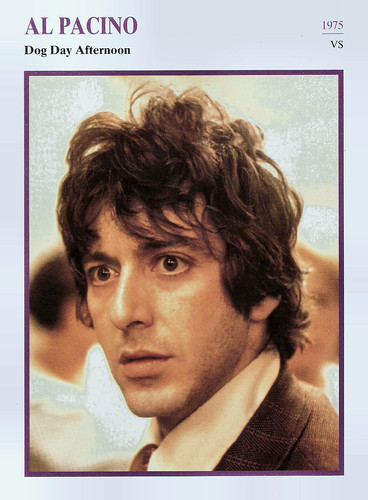
Dutch collectors card in the series 'Filmsterren: een Portret' by Edito Service, 1993. Photo: Stars-Films. Al Pacino in Dog Day Afternoon (Sidney Lumet, 1975).
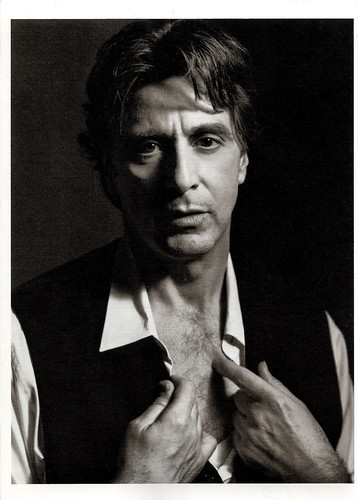
American postcard by Fotofolio, New York, no. HR73. Photo: Herb Ritts. Caption: Al Pacino, New York City, 1992.
Sources: Keith Phipps (AllMovie), (IMDb), Wikipedia and .

British postcard by Star-Graphics, no. S 89. Photo: Al Pacino in The Godfather (Francis Ford Coppola, 1972).

British postcard by Star-Graphics, no. S 91. Photo: Al Pacino and Marlon Brando in The Godfather (Francis Ford Coppola, 1972).

French postcard in the Collection In Cinéma by Editions La Malibran, Paris / Nancy, 1989, no. CA 51. Photo: Al Pacino in Scarecrow (Jerry Schatzberg, 1973).
Michael Corleone
Alfredo James 'Al' Pacino was born in 1940 in Manhattan, New York City, to Italian-American parents, Rose (nee Gerardi) and Sal Pacino, who worked as an insurance agent. His maternal grandfather was born in Corleone, Sicily. His parents divorced when he was two years old.
His mother moved them into his grandparents' home in the South Bronx. In his teenage years, Pacino was known as 'Sonny' to his friends. Pacino found himself often repeating the plots and voices of characters he had seen in films. Bored and unmotivated in school, he found a haven in school plays, and his interest soon blossomed into a full-time career.
He attended the High School of the Performing Arts until he dropped out at age 17. In 1962, Pacino's mother died at the age of 43. The following year, his grandfather James also died. Starting on stage, he went through a period of depression and poverty, sometimes having to borrow bus fare to succeed to auditions. He made it into the prestigious Actors Studio in 1966, studying under Lee Strasberg, creator of the Method Approach that would become the trademark of many 1970s-era actors.
After appearing in a string of plays in supporting roles, Pacino finally attained success off-Broadway with Israel Horovitz's 'The Indian Wants the Bronx', winning an Obie Award for the 1966-1967 season. He was also nominated for a Best Actor Obie for 'Why Is a Crooked Letter' (1966). That was followed by a Tony Award for 'Does the Tiger Wear a Necktie?'
Pacino was a longtime member of David Wheeler's Theatre Company of Boston, for which he performed in 'Richard III' in Boston (1972-1973) and at the Cort Theater in New York City (1979). He also appeared in their productions of Bertolt Brecht's 'Arturo Ui' at the Charles Theater in Boston in 1975 and later in New York and London, and in David Rabe's 'The Basic Training of Pavlo Hummel' at the Longacre Theater in New York in 1977.
At the age of 29 he made his film debut with a supporting part in Me, Natalie (Fred Coe, 1969) featuring Patty Duke. In 1970, Pacino signed with the talent agency Creative Management Associates (CMA). He gained favourable notice for his first lead role as a heroin addict in The Panic in Needle Park (Jerry Schatzberg, 1971). These first feature films made a little departure from the gritty realistic stage performances that earned him respect.
Then came the role of Michael Corleone in The Godfather (Francis Ford Coppola, 1972). It was one of the most sought-after of the time: Robert Redford, Warren Beatty, Jack Nicholson , Ryan O'Neal, Robert De Niro and a host of other actors either wanted it or were mentioned. Pacino was rejected repeatedly by studio heads for the role, but Francis Ford Coppola fought for him. Coppola was successful but Pacino was reportedly in constant fear of being fired during the very difficult shoot. Ironically, The Godfather (1972) was a monster hit that earned Pacino his first Academy Award nomination for Best Supporting Actor. It turned out to be the breakthrough for both Pacino and director Francis Ford Coppola.

French postcard by Travelling Editions, Paris, no. CP7. Photo: Al Pacino in Scarecrow (Jerry Schatzberg, 1973).

Romanian postcard by Casa Filmului Acin. Photo: Al Pacino in Scarecrow (Jerry Schatzberg, 1973).

Romanian postcard by Casa Filmului Acin. Photo: Al Pacino in Serpico (Sidney Lumet, 1973).
Three consecutive Oscar nominations
Instead of taking on easier projects for the big money after this success, Al Pacino threw his support behind what he considered tough but important films. In 1973, Pacino co-starred in Scarecrow (Jerry Schatzberg, 1973), with Gene Hackman, and won the Palme d'Or at the Cannes Film Festival.
He also starred in the true-life crime drama Serpico (Sidney Lumet, 1973) and the tragic real-life bank robbery film Dog Day Afternoon (Sidney Lumet, 1975). In between, he returned as Michael Corleone in The Godfather: Part II (Francis Ford Coppola, 1974), the first sequel ever to win the Best Picture Oscar. For these three films, Pacino was nominated three consecutive years for the Best Actor Academy Award.
In 1977, he won his second Tony Award as Best Actor (Play) for 'The Basic Training of Pavlo Hummel' (1977). He faltered slightly with Bobby Deerfield (Sydney Pollack, 1977), but regained his stride with ...and justice for all. (Norman Jewison, 1979), for which he received another Academy Award nomination for Best Actor.
Unfortunately, this would signal the beginning of a decline in his career, which produced flops like the controversial Cruising (William Friedkin, 1980), and the comedy-drama Author! Author! (Arthur Hiller, 1982), with Dyan Cannon and Tuesday Weld.
Pacino cemented his legendary status with his role as Cuban drug lord Tony Montana in the ultra-violent cult film Scarface (Brian De Palma, 1983), with Michelle Pfeiffer and Steven Bauer. Keith Phipps at AllMovie : "Infinitely quotable and more than a little cartoonish, Brian De Palma's update of Howard Hawks' seminal gangster film revels in its freedom to be larger than life. A work as akin to pop art as any other form, it reworks the crime melodrama in bold, primary colors, mostly blood red. Attracting a great deal of attention for its violence at the time of its release, the controversy overshadowed the fact that everything in the film ran to extremes, including Pacino's performance, the director's visual style (which found him almost reverting to The Fury mode), the dialogue (from a script co-written by Oliver Stone), and most importantly the themes. "
Pedro Borges at IMDb : "a monumental mistake was about to follow. Revolution (Hugh Hudson, 1985) endured an endless and seemingly cursed shoot in which equipment was destroyed, the weather was terrible, and Pacino fell ill with pneumonia. Constant changes in the script further derailed the project. The Revolutionary War-themed film, considered among the worst films ever made, resulted in awful reviews and kept him off the screen for the next four years."
Returning to the stage, Pacino did much to give back and contribute to the theatre, which he considers his first love. He directed a film, The Local Stigmatic (1990), but it remains unreleased. He lifted his self-imposed exile playing a hard-drinking policeman in the striking Sea of Love (Harold Becker, 1989), with Ellen Barkin. This marked the second phase of Pacino's career, being the first to feature his now famous dark, owl eyes, and hoarse, gravelly voice.

Big postcard by Pyramid Posters, Leicester, no. SPC9608. Photo: Universal Studios. Al Pacino in Scarface (Brian De Palma, 1983).

Postcard, no. C120. Photo: poster for Scarface (Brian De Palma, 1983). Collection: Daniël van der Aa.

French postcard. Photo: Universal Studios. Al Pacino in Scarface (Brian De Palma, 1983).
Playing Satan
Returning to the Corleones, Al Pacino made The Godfather: Part III (Francis Ford Coppola, 1990) and earned raves for his first comedic role in the colourful adaptation Dick Tracy (Warren Beatty, 1990). This earned him another Academy Award nomination for Best Supporting Actor, and two years later he was nominated for Glengarry Glen Ross (James Foley, 1992).
He went into romantic mode for Frankie and Johnny (Garry Marshall, 1991) with Michelle Pfeiffer . In 1992, he finally won the Academy Award for Best Actor for his amazing performance as the blind U.S. Army Lieutenant Colonel Frank Slade in Scent of a Woman (Martin Brest, 1992). A mixture of technical perfection and charisma, the role was tailor-made for him and remains a classic.
The next few years would see Pacino becoming more comfortable with acting and films as a business, turning out great roles in great films with more frequency and less of the demanding personal involvement of his wilder days. Carlito's Way (Brian De Palma, 1993) with Sean Penn proved another gangster classic, as did the epic crime drama Heat (Michael Mann, 1995) co-starring Robert De Niro .
He directed the theatrical docudrama Looking for Richard (1996), a performance of selected scenes of William Shakespeare's 'Richard III' and a broader examination of Shakespeare's continuing role and relevance in popular culture. In Donnie Brasco (Mike Newell, 1997), Pacino played gangster 'Lefty' in the true story of undercover FBI agent Donnie Brasco ( Johnny Depp ) and his work in bringing down the Mafia from the inside.
Pacino played Satan in the supernatural thriller The Devil's Advocate (Taylor Hackford, 1997) which co-starred Keanu Reeves . The film was a success at the box office, taking US$150 million worldwide. He also gave commanding performances in The Insider (Michael Mann, 1999) with Russell Crowe, and Any Given Sunday (Oliver Stone, 1999) opposite Cameron Diaz .

Dutch postcard by Boomerang, Amsterdam. Photo: Al Pacino in Carlito's Way (Brian De Palma, 1993).
Once Upon a Time in Hollywood
Al Pacino co-starred with Hillary Swank and Robin Williams in the mystery thriller Insomnia (Christopher Nolan, 2002), a remake of the Norwegian film of the same name. Pacino starred as Shylock in Michael Radford's film adaptation of The Merchant of Venice (2004), choosing to bring compassion and depth to a character traditionally played as a villainous caricature.
In the 2000s, he starred in a number of theatrical blockbusters, including Ocean's Thirteen (Steven Soderbergh, 2007) with George Clooney and Brad Pitt , but his choice in television roles like the vicious, closeted Roy Cohn in the HBO miniseries Angels in America (Tony Kushner, 2003) and his sensitive portrayal of Jack Kevorkian, in the television film You Don't Know Jack (Barry Levinson, 2010), are reminiscent of the bolder choices of his early career. Each television project garnered him an Emmy Award for Outstanding Lead Actor in a Miniseries or a Movie.
Recently, Pacino starred alongside Brad Pitt and Leonardo DiCaprio in Quentin Tarantino's comedy-drama Once Upon a Time in Hollywood (2019) and he co-starred with Robert De Niro in Martin Scorsese's Netflix film The Irishman (2019). He will play Meyer Offerman, a fictional Nazi hunter, in the Amazon Video series Hunters.
Never wed, Pacino has a daughter, Julie Marie, with acting teacher Jan Tarrant, and a set of twins with former longtime girlfriend Beverly D'Angelo. His romantic history includes Veruschka von Lehndorff, Jill Clayburgh, Debra Winger, Tuesday Weld, Marthe Keller , Carmen Cervera, Kathleen Quinlan, Lyndall Hobbs, Penelope Ann Miller, and a two-decade intermittent relationship with Godfather co-star Diane Keaton.
Since 2007, Al Pacino lives with Argentinian actress Lucila Solá, who is 36 years his junior. In 2007, the American Film Institute awarded Pacino with a lifetime achievement award.

Dutch collectors card in the series 'Filmsterren: een Portret' by Edito Service, 1993. Photo: Stars-Films. Al Pacino in Dog Day Afternoon (Sidney Lumet, 1975).

American postcard by Fotofolio, New York, no. HR73. Photo: Herb Ritts. Caption: Al Pacino, New York City, 1992.
Sources: Keith Phipps (AllMovie), (IMDb), Wikipedia and .
Published on March 19, 2020 23:00
March 18, 2020
Paul Mounet
Paul Mounet (1847–1922), born Jean-Paul Sully, was a legendary French actor of the Comédie Française. Around 1910, he acted in various Film d'Art productions, but little was known about these early silent films. For EFSP, Ivo Blom reconstructed in which films Mounet appeared.

French postcard. Photo: Boyer, Paris. Caption: Paul Mounet de la Comédie Française.
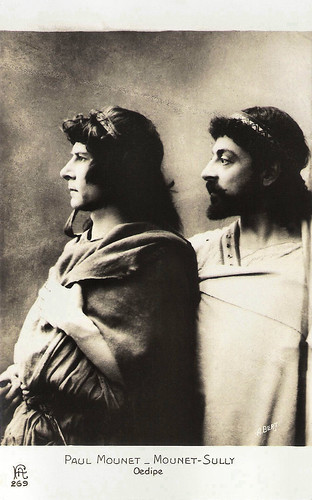
French postcard by F.A., printed by A. Christensen, imp, Rueil, no. 269. Photo: A. Bert. Paul Mounet and Mounet-Sully in the stage play 'Oedipe Roi' (Oedipus Rex) by Sophocles at the Comédie-Française in 1892.
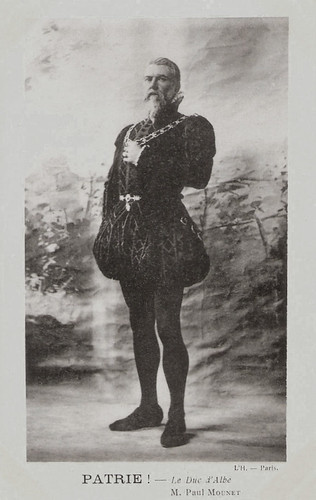
French postcard. Photo: L'H, Paris. Paul Mounet as Le Duc d'Albe in Patrie! (1901) by Victorien Sardou and presented by the Comédie-Française.
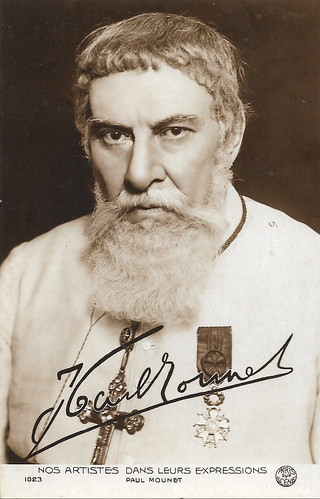
French postcard in the Nos artistes dans leurs expressions series, no. 1023. Photo: Paris sur scène. Paul Monet in Par la vérité/By the truth (Maurice de Féraudy, Gaston Leprieur, 1917).
Correcting a few errors
Paul Mounet was born in Bergerac, Dordogne, in 1847. He was the younger brother of actor Jean Mounet-Sully aka Mounet-Sully .
Paul studied to become a medical doctor prior to his career in acting. He made his stage debut in 1880 in Paris at the Odéon's production of 'Horace'. All through the 1880s, he acted at the Odeon. It was in 1889 that he first played at the Comédie-Française, of which he became a sociétaire two years later. Mounet garnered acclaim for his roles in 'Les Érinnyes', 'L'Arlésienne', 'Severo Torelli', 'Othello', 'Patrie', 'Hamlet', and 'Œdipe Roi'.
Between 1908 and 1917, Paul Mounet appeared in a number of films, mostly Film d'Art-like productions at the companies Le Film d'Art, Pathé and Eclipse, and often based on previous stage successes by Mounet.
However, IMDb makes quite a few errors in Mounet's filmography. Either he or André Calmettes may have acted as Scarpia in a version of La Tosca (Charles Le Bargy, André Calmettes, 1908) with Sarah Bernhardt , but this version had only a very short release in December 1908, while Bernhardt had even forbidden the showing of the film.
In January 1909 a new version was made by Le Film d'Art with Cécile Sorel in the lead and Charles Le Bargy as Scarpia, so not Mounet. Neither was he in Rigoletto, the American title for Le roi 's amuse (Albert Capellani, 1909). Also, it was NOT Paul Mounet but his brother Mounet-Sully who acted in Le baiser de Judas (André Calmettes, Armand Bour, 1909).
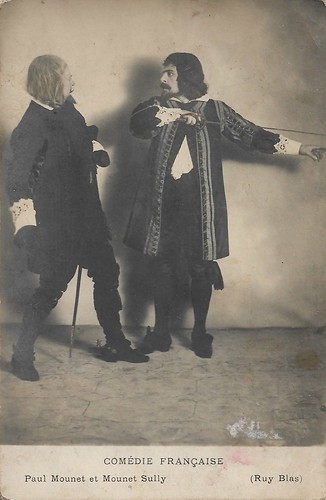
French postcard. Paul Mounet and Mounet-Sully in 'Ruy Blas' by Victor Hugo, Comédie Française.
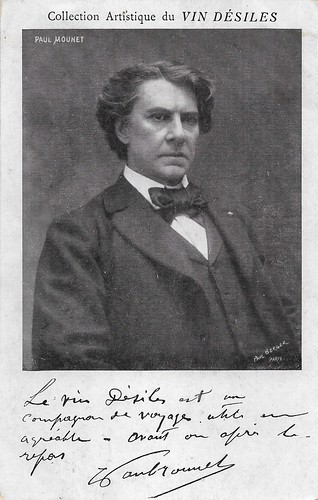
French postcard in the Collection Artistique du Vin Désiles. Photo: Paul Berger, Paris. Caption: Vin Désiles is a useful and pleasant travel companion - before or after the meal.
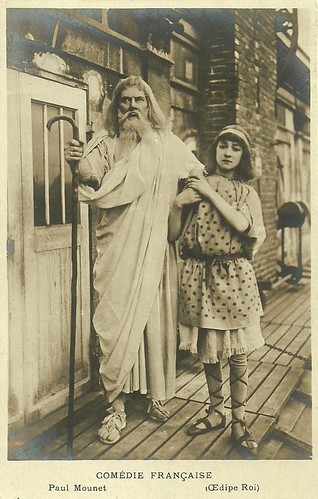
French postcard. Paul Mounet as Tiresias in 'Oedipe Roi' by Sophocles at the Comédie Française.
Historical films and stage adaptations
Paul Mounet DID play Ulysses opposite Julia Bartet as Penelope and Albert Lambert as Antinuous in Le retour d'Ulysse/The Return of Ulysses (André Calmettes, Charles Le Bargy, 1909), and he played the Shakespearian title character Macbeth opposite Jeanne Delvair as Lady Macbeth in Macbeth (André Calmettes, 1909). In 1884 Mounet had already played Macbeth at the Théâtre de l'Odéon, and in 1914 he would play the role again, now at the Comédie Française.
Released in 1910 (and not 1909 as IMDb writes) were Mounet's films Rival de son père (André Calmettes, 1910) based on Schiller's 'Don Carlos', also with Emile Dehelly and Julia Bartet, and Louis XI (André Calmettes, 1910) with again Dehelly and Bartet, though the latter may have been a mix up with L'Héritière/The heiress.
In 1910 indeed Mouniet had the lead of Louis XI in L'Héritière/The heiress (Henri Pouctal or André Calmettes, 1910), also with Henri Rollan as The Duke of Nemours and Mlle Gilman as Marie of Burgundy, daughter of Charles the Bold and heiress of a vast territory, which the French king Louis XI would like to conquer.
In 1912 he acted in his last Film d'Art production, Les Jacobites/The Jacobites, for whom the director is unknown, and in which Jeanne Provost and Emile Dehelly were Mounet's co-actors. He had already played the role on stage in 1885.
Inspired by the Film d'Art productions, the new company Eclipse (1906) started to make historical films and stage adaptations as well, and launched in 1912 La légende d'Oedipe/The legend of Oedipus (released December 1913), directed by Gaston Roudès. Sophocles' tragedy had already been brought to the screen by André Calmettes for Le Film d'Art in 1910, with Mounet's brother Mounet-Sully in the lead.
Mounet-Sully had performed the play from 1901 and it had become his 'pièce de resistance'. His brother Paul had played the blind prophet and clairvoyant Tiresias in the same play. In 1912 Eclipse asked Mounet-Sully to play his star role gain, and asked his brother to play Tiresias again. Jeanne Delvair played Jocaste, Jean Hervé young Oedipus, and Louis Delaunay Creon. Mounet-Sully scripted the film.
His last fiction film part, Paul Mounet played as the Reverend Father Aurégan in the courtroom drama Par la vérité/By the truth (Maurice de Féraudy, Gaston Leprieur, 1917), based on Ernest Daudet's story, and starring Marcelle Géniat. In court, without betraying his vow of confidentiality, the priest makes clear the supposed culprit of murder is innocent.
Paul Mounet served as a professor at the Paris Conservatoire, teaching, among others, Pierre Fresnay , Valentine Tessier, Hélène Dieudonné, Léonce Perret, Daniel Mendaille, Françoise Rosay , and Marie Ventura . He became a Chevalier in the Legion of Honour.
Mounet died of heart disease in 1922. In 1880 he had married the opera singer Madeleine Andrée Barbot (1852-1923), who also knew a brief career as tragedy actress in the 1880s, before returning to opera.
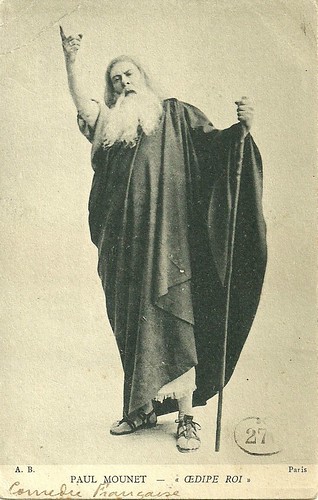
French postcard by A.B., Paris. Paul Mounet in the play 'Oedipe Roi' by Sophocles.
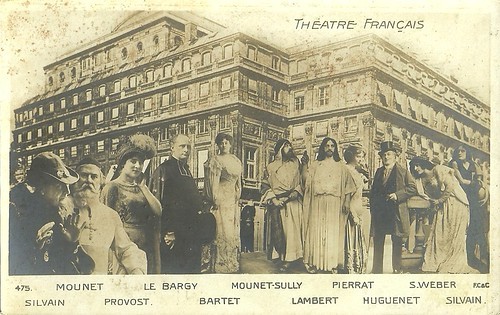
French postcard by F.C. & Cie., Paris, no. 475. This cards shows a 1920s photomontage of the actors of the Comédie Française, partly dressed in the costumes of their most famous plays. In the back, the Théàtre Français, home of the Comédie. From left to right: (Eugène) Silvain / Sylvain, Paul Mounet, Jeanne Provost, Charles Le Bargy , Julia Bartet, Jean Mounet-Sully , Albert Lambert , Pierrat, Huguenet, Ségond-Weber, Louise Silvain. Almost all of these actors also had a film career, either in the Film d'Art films of the early 1910s, or (also) at later stages.
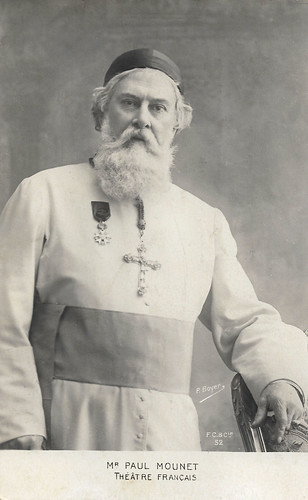
French postcard by F.C. & Cie, no. 52. Photo: P. Boyer. Caption: Theatre Francais. Mounet's costume seems to refer to his last film, Par la vérité/By the truth (1917).
Sources: Ciné-Ressources (French), Fondation Seydoux Pathé (French), 1895 (French), Wikipedia and
NB The film Rival de son père (1909) is not mentioned at the Seydoux Pathé site, but is mentioned in the Le Film d'Art filmography in the journal 1895, as well as on the Ciné-Ressources website. Neither is the film Les Jacobites (1912) mentioned at the Pathé website, but is part of the Ciné-Ressources website.

French postcard. Photo: Boyer, Paris. Caption: Paul Mounet de la Comédie Française.

French postcard by F.A., printed by A. Christensen, imp, Rueil, no. 269. Photo: A. Bert. Paul Mounet and Mounet-Sully in the stage play 'Oedipe Roi' (Oedipus Rex) by Sophocles at the Comédie-Française in 1892.

French postcard. Photo: L'H, Paris. Paul Mounet as Le Duc d'Albe in Patrie! (1901) by Victorien Sardou and presented by the Comédie-Française.

French postcard in the Nos artistes dans leurs expressions series, no. 1023. Photo: Paris sur scène. Paul Monet in Par la vérité/By the truth (Maurice de Féraudy, Gaston Leprieur, 1917).
Correcting a few errors
Paul Mounet was born in Bergerac, Dordogne, in 1847. He was the younger brother of actor Jean Mounet-Sully aka Mounet-Sully .
Paul studied to become a medical doctor prior to his career in acting. He made his stage debut in 1880 in Paris at the Odéon's production of 'Horace'. All through the 1880s, he acted at the Odeon. It was in 1889 that he first played at the Comédie-Française, of which he became a sociétaire two years later. Mounet garnered acclaim for his roles in 'Les Érinnyes', 'L'Arlésienne', 'Severo Torelli', 'Othello', 'Patrie', 'Hamlet', and 'Œdipe Roi'.
Between 1908 and 1917, Paul Mounet appeared in a number of films, mostly Film d'Art-like productions at the companies Le Film d'Art, Pathé and Eclipse, and often based on previous stage successes by Mounet.
However, IMDb makes quite a few errors in Mounet's filmography. Either he or André Calmettes may have acted as Scarpia in a version of La Tosca (Charles Le Bargy, André Calmettes, 1908) with Sarah Bernhardt , but this version had only a very short release in December 1908, while Bernhardt had even forbidden the showing of the film.
In January 1909 a new version was made by Le Film d'Art with Cécile Sorel in the lead and Charles Le Bargy as Scarpia, so not Mounet. Neither was he in Rigoletto, the American title for Le roi 's amuse (Albert Capellani, 1909). Also, it was NOT Paul Mounet but his brother Mounet-Sully who acted in Le baiser de Judas (André Calmettes, Armand Bour, 1909).

French postcard. Paul Mounet and Mounet-Sully in 'Ruy Blas' by Victor Hugo, Comédie Française.

French postcard in the Collection Artistique du Vin Désiles. Photo: Paul Berger, Paris. Caption: Vin Désiles is a useful and pleasant travel companion - before or after the meal.

French postcard. Paul Mounet as Tiresias in 'Oedipe Roi' by Sophocles at the Comédie Française.
Historical films and stage adaptations
Paul Mounet DID play Ulysses opposite Julia Bartet as Penelope and Albert Lambert as Antinuous in Le retour d'Ulysse/The Return of Ulysses (André Calmettes, Charles Le Bargy, 1909), and he played the Shakespearian title character Macbeth opposite Jeanne Delvair as Lady Macbeth in Macbeth (André Calmettes, 1909). In 1884 Mounet had already played Macbeth at the Théâtre de l'Odéon, and in 1914 he would play the role again, now at the Comédie Française.
Released in 1910 (and not 1909 as IMDb writes) were Mounet's films Rival de son père (André Calmettes, 1910) based on Schiller's 'Don Carlos', also with Emile Dehelly and Julia Bartet, and Louis XI (André Calmettes, 1910) with again Dehelly and Bartet, though the latter may have been a mix up with L'Héritière/The heiress.
In 1910 indeed Mouniet had the lead of Louis XI in L'Héritière/The heiress (Henri Pouctal or André Calmettes, 1910), also with Henri Rollan as The Duke of Nemours and Mlle Gilman as Marie of Burgundy, daughter of Charles the Bold and heiress of a vast territory, which the French king Louis XI would like to conquer.
In 1912 he acted in his last Film d'Art production, Les Jacobites/The Jacobites, for whom the director is unknown, and in which Jeanne Provost and Emile Dehelly were Mounet's co-actors. He had already played the role on stage in 1885.
Inspired by the Film d'Art productions, the new company Eclipse (1906) started to make historical films and stage adaptations as well, and launched in 1912 La légende d'Oedipe/The legend of Oedipus (released December 1913), directed by Gaston Roudès. Sophocles' tragedy had already been brought to the screen by André Calmettes for Le Film d'Art in 1910, with Mounet's brother Mounet-Sully in the lead.
Mounet-Sully had performed the play from 1901 and it had become his 'pièce de resistance'. His brother Paul had played the blind prophet and clairvoyant Tiresias in the same play. In 1912 Eclipse asked Mounet-Sully to play his star role gain, and asked his brother to play Tiresias again. Jeanne Delvair played Jocaste, Jean Hervé young Oedipus, and Louis Delaunay Creon. Mounet-Sully scripted the film.
His last fiction film part, Paul Mounet played as the Reverend Father Aurégan in the courtroom drama Par la vérité/By the truth (Maurice de Féraudy, Gaston Leprieur, 1917), based on Ernest Daudet's story, and starring Marcelle Géniat. In court, without betraying his vow of confidentiality, the priest makes clear the supposed culprit of murder is innocent.
Paul Mounet served as a professor at the Paris Conservatoire, teaching, among others, Pierre Fresnay , Valentine Tessier, Hélène Dieudonné, Léonce Perret, Daniel Mendaille, Françoise Rosay , and Marie Ventura . He became a Chevalier in the Legion of Honour.
Mounet died of heart disease in 1922. In 1880 he had married the opera singer Madeleine Andrée Barbot (1852-1923), who also knew a brief career as tragedy actress in the 1880s, before returning to opera.

French postcard by A.B., Paris. Paul Mounet in the play 'Oedipe Roi' by Sophocles.

French postcard by F.C. & Cie., Paris, no. 475. This cards shows a 1920s photomontage of the actors of the Comédie Française, partly dressed in the costumes of their most famous plays. In the back, the Théàtre Français, home of the Comédie. From left to right: (Eugène) Silvain / Sylvain, Paul Mounet, Jeanne Provost, Charles Le Bargy , Julia Bartet, Jean Mounet-Sully , Albert Lambert , Pierrat, Huguenet, Ségond-Weber, Louise Silvain. Almost all of these actors also had a film career, either in the Film d'Art films of the early 1910s, or (also) at later stages.

French postcard by F.C. & Cie, no. 52. Photo: P. Boyer. Caption: Theatre Francais. Mounet's costume seems to refer to his last film, Par la vérité/By the truth (1917).
Sources: Ciné-Ressources (French), Fondation Seydoux Pathé (French), 1895 (French), Wikipedia and
NB The film Rival de son père (1909) is not mentioned at the Seydoux Pathé site, but is mentioned in the Le Film d'Art filmography in the journal 1895, as well as on the Ciné-Ressources website. Neither is the film Les Jacobites (1912) mentioned at the Pathé website, but is part of the Ciné-Ressources website.
Published on March 18, 2020 23:00
March 17, 2020
Blessée au coeur (1917)
Today, we end the film specials series with Spanish chocolate cards with a post on the silent French film, Blessée au coeur/Wounded in the heart (1917), starring Jeanne Delvair, Jean Ayme and René Rocher. The film was produced by Pathé Frères, but the director is unknown. The series of 6 cards was produced by Ed. Auber y Pla for Chocolate Pi in Barcelona. The Spanish release title of the film was Herida del corazon and the distributor of the film in Spain was Vilaseca y Ledesma.
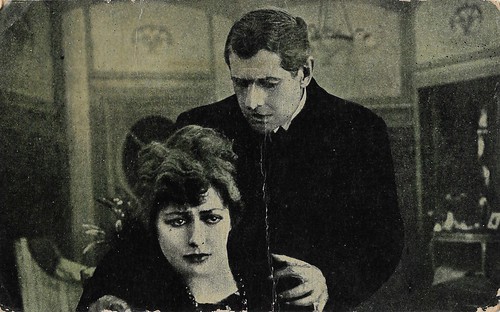
Spanish postcard by Ed. Auber y Pla, Barcelona for Chocolate Pi, Barcelona, no. 1 of 6 cards. Photo: Pathé Frères. Publicity still for Blessée au coeur (1917). The actress is not Jeanne Delvair, but an unknown actress who plays the lady the banker wants to elope with.
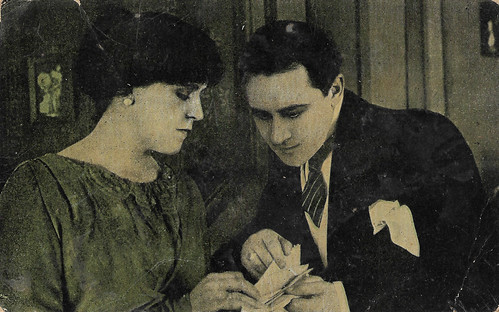
Spanish postcard by Ed. Auber y Pla, Barcelona for Chocolate Pi, Barcelona, no. 2 of 6 cards. Photo: Pathé Frères. Jeanne Delvair and René Rocher in Blessée au coeur (1917).
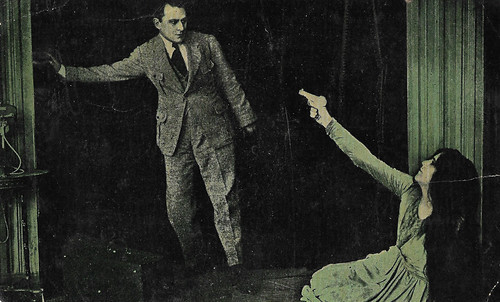
Spanish postcard by Ed. Auber y Pla, Barcelona for Chocolate Pi, Barcelona, no. 3 of 6 cards. Photo: Pathé Frères. Jeanne Delvair and Jean Ayme in Blessée au coeur (1917).
A Shot in the Dark
In Blessée au coeur (1917), the banker Beaupreault (Jean Ayme) has done wild speculations to satisfy his extraordinary needs. One night, while waiting for his wife Marguerite (Jeanne Delvair), he feels the imminent disaster coming. Their son Gérard (René Rocher), unknowing of the debacle, celebrates the passing of his exams.
The opulent rich Robert Dalmarre (Georges Tréville) is prepared to save Marguerite from catastrophe. Beaupreault, who already has prepared his flight with the ex-wife of his attorney Collinet (Jacques Volnys), then hears of the offer his friend is willing to make to save his honour.
Meanwhile, because of alarming rumours around the bank, the creditor Haudecoeur (Jean Chameroy) surprises the banker preparing his luggage, and with a gun in his hand, he demands the restitution of his loans. The banker yields, but this delay is fatal, as Marguerite comes to tell him about her son's success. She quickly understands her husband's plans, and in vain pleas him to renounce to them, but the banker brutally throws her on the ground.
Marguerite finds the gun of Haudecoeur and points it at the banker. Then the banker quickly switches off the electricity to flee. A shot goes off in the dark...
The previous scene lasts briefly, surprising Haudecoeur, who is still on the stairs. The bank staff is surprised to find him in the banker's apartments as he entered without their knowledge, so they suspect him of the killing.
The drama has shocked Marguerite, but when her wits return she learns that the murderer has fallen in the hands of Justice. Marguerite has no doubt she herself has fired the gun on her husband. She is about to declare this before the judge, but her maternal egoism prevents this. The timely arrival of Robert Dalmarre clears her sad thoughts when the latter explains the true murderer was Collinet, who used the darkness created by the banker to kill him to prevent his flight with his own ex-wife.
Collinet is convicted and confesses his crime. Haudecoeur is freed and Marguerite liberated from the doubts that tormented her mind, will forget, with her two loved ones [her son and Robert], the intense drama which was about to steal her reason.
Blessée au coeur was a production by the Société cinématographique des auteurs et gens de lettres (SCAGL), part of Pathé Frères. Pathé also distributed the film. The film was based on a novel (1895) by Jules Mary. According to the newspapers of 1917 on Gallica , the film was released almost simultaneously at the Parisian cinemas Pathé-Palace, Omnia-Pathé and Artistic around 20 April 1917.
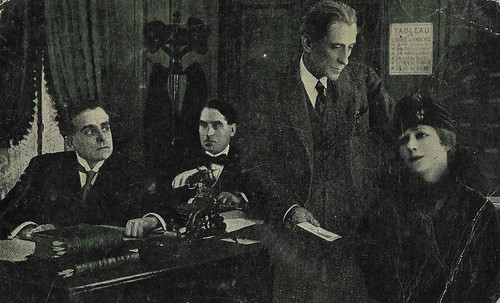
Spanish postcard by Ed. Auber y Pla, Barcelona for Chocolate Pi, Barcelona, no. 4 of 6 cards. Photo: Pathé Frères. Georges Tréville in Blessée au coeur (1917). The actress does not look like Delvair, so she could be the unknown actress who plays the lady with whom the banker planned to flee (see card 1).
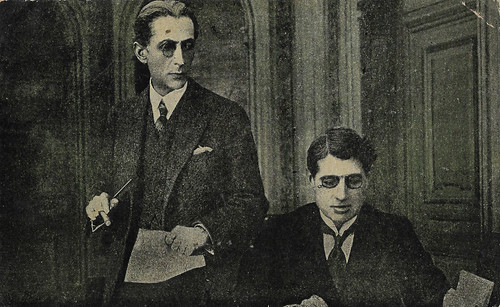
Spanish postcard by Ed. Auber y Pla, Barcelona for Chocolate Pi, Barcelona, no. 5 of 6 cards. Photo: Pathé Frères. Georges Tréville in Blessée au coeur (1917). The actor on the right may be Jacques Volnys.
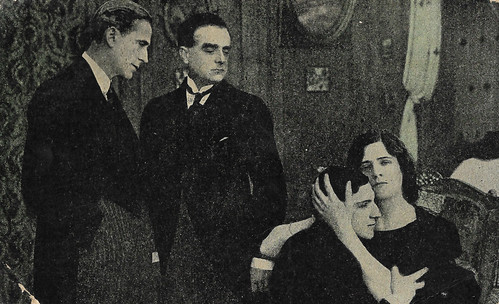
Spanish postcard by Ed. Auber y Pla, Barcelona for Chocolate Pi, Barcelona, no. 6 of 6 cards. Photo: Pathé Frères. Georges Tréville, René Rocher and Jeanne Delvair in Blessée au coeur (1917).
Sources: Wikipedia (French), IMDb, Ciné-Ressources, Fondation Seydoux-Pathé, Gallica, and the collectors cards.
N.B. The French databases only mention Georges Tréville's collaboration but from these cards, it is clear he played Robert Dalmarre.

Spanish postcard by Ed. Auber y Pla, Barcelona for Chocolate Pi, Barcelona, no. 1 of 6 cards. Photo: Pathé Frères. Publicity still for Blessée au coeur (1917). The actress is not Jeanne Delvair, but an unknown actress who plays the lady the banker wants to elope with.

Spanish postcard by Ed. Auber y Pla, Barcelona for Chocolate Pi, Barcelona, no. 2 of 6 cards. Photo: Pathé Frères. Jeanne Delvair and René Rocher in Blessée au coeur (1917).

Spanish postcard by Ed. Auber y Pla, Barcelona for Chocolate Pi, Barcelona, no. 3 of 6 cards. Photo: Pathé Frères. Jeanne Delvair and Jean Ayme in Blessée au coeur (1917).
A Shot in the Dark
In Blessée au coeur (1917), the banker Beaupreault (Jean Ayme) has done wild speculations to satisfy his extraordinary needs. One night, while waiting for his wife Marguerite (Jeanne Delvair), he feels the imminent disaster coming. Their son Gérard (René Rocher), unknowing of the debacle, celebrates the passing of his exams.
The opulent rich Robert Dalmarre (Georges Tréville) is prepared to save Marguerite from catastrophe. Beaupreault, who already has prepared his flight with the ex-wife of his attorney Collinet (Jacques Volnys), then hears of the offer his friend is willing to make to save his honour.
Meanwhile, because of alarming rumours around the bank, the creditor Haudecoeur (Jean Chameroy) surprises the banker preparing his luggage, and with a gun in his hand, he demands the restitution of his loans. The banker yields, but this delay is fatal, as Marguerite comes to tell him about her son's success. She quickly understands her husband's plans, and in vain pleas him to renounce to them, but the banker brutally throws her on the ground.
Marguerite finds the gun of Haudecoeur and points it at the banker. Then the banker quickly switches off the electricity to flee. A shot goes off in the dark...
The previous scene lasts briefly, surprising Haudecoeur, who is still on the stairs. The bank staff is surprised to find him in the banker's apartments as he entered without their knowledge, so they suspect him of the killing.
The drama has shocked Marguerite, but when her wits return she learns that the murderer has fallen in the hands of Justice. Marguerite has no doubt she herself has fired the gun on her husband. She is about to declare this before the judge, but her maternal egoism prevents this. The timely arrival of Robert Dalmarre clears her sad thoughts when the latter explains the true murderer was Collinet, who used the darkness created by the banker to kill him to prevent his flight with his own ex-wife.
Collinet is convicted and confesses his crime. Haudecoeur is freed and Marguerite liberated from the doubts that tormented her mind, will forget, with her two loved ones [her son and Robert], the intense drama which was about to steal her reason.
Blessée au coeur was a production by the Société cinématographique des auteurs et gens de lettres (SCAGL), part of Pathé Frères. Pathé also distributed the film. The film was based on a novel (1895) by Jules Mary. According to the newspapers of 1917 on Gallica , the film was released almost simultaneously at the Parisian cinemas Pathé-Palace, Omnia-Pathé and Artistic around 20 April 1917.

Spanish postcard by Ed. Auber y Pla, Barcelona for Chocolate Pi, Barcelona, no. 4 of 6 cards. Photo: Pathé Frères. Georges Tréville in Blessée au coeur (1917). The actress does not look like Delvair, so she could be the unknown actress who plays the lady with whom the banker planned to flee (see card 1).

Spanish postcard by Ed. Auber y Pla, Barcelona for Chocolate Pi, Barcelona, no. 5 of 6 cards. Photo: Pathé Frères. Georges Tréville in Blessée au coeur (1917). The actor on the right may be Jacques Volnys.

Spanish postcard by Ed. Auber y Pla, Barcelona for Chocolate Pi, Barcelona, no. 6 of 6 cards. Photo: Pathé Frères. Georges Tréville, René Rocher and Jeanne Delvair in Blessée au coeur (1917).
Sources: Wikipedia (French), IMDb, Ciné-Ressources, Fondation Seydoux-Pathé, Gallica, and the collectors cards.
N.B. The French databases only mention Georges Tréville's collaboration but from these cards, it is clear he played Robert Dalmarre.
Published on March 17, 2020 23:00
Paul van Yperen's Blog
- Paul van Yperen's profile
- 13 followers
Paul van Yperen isn't a Goodreads Author
(yet),
but they
do have a blog,
so here are some recent posts imported from
their feed.



